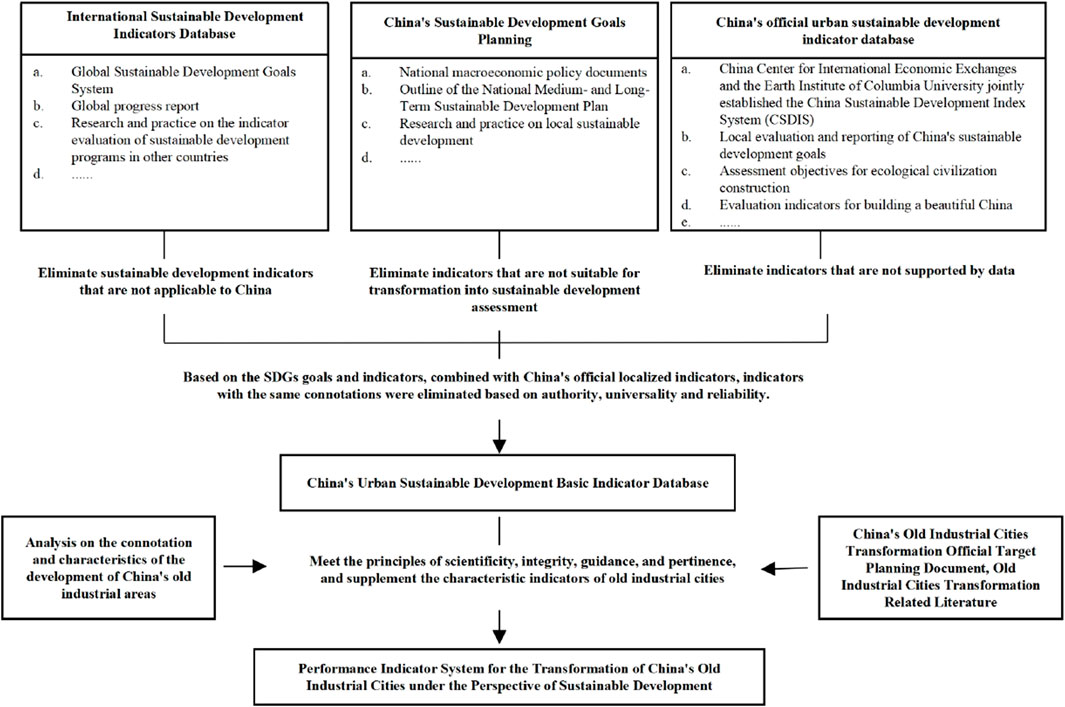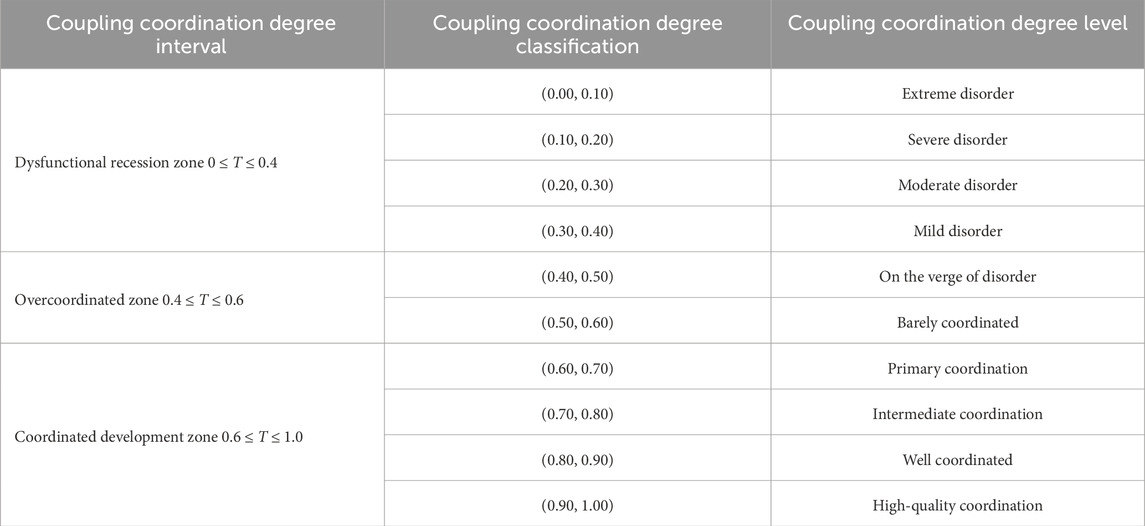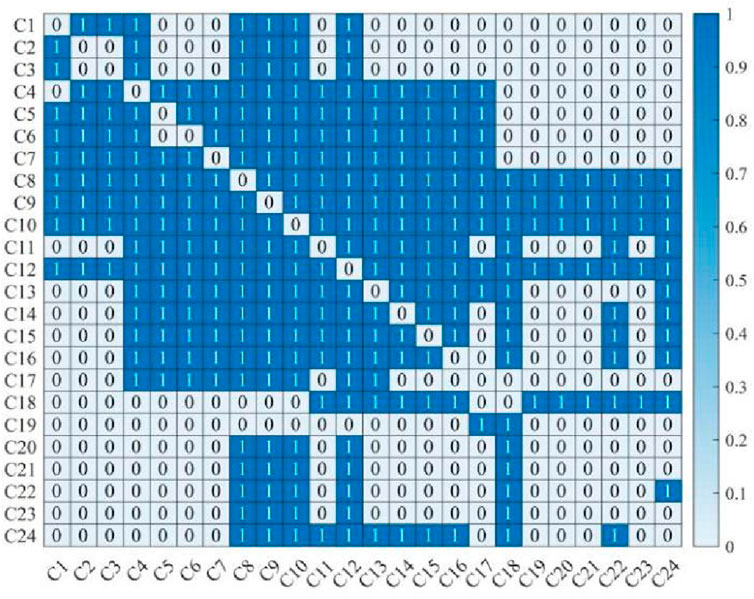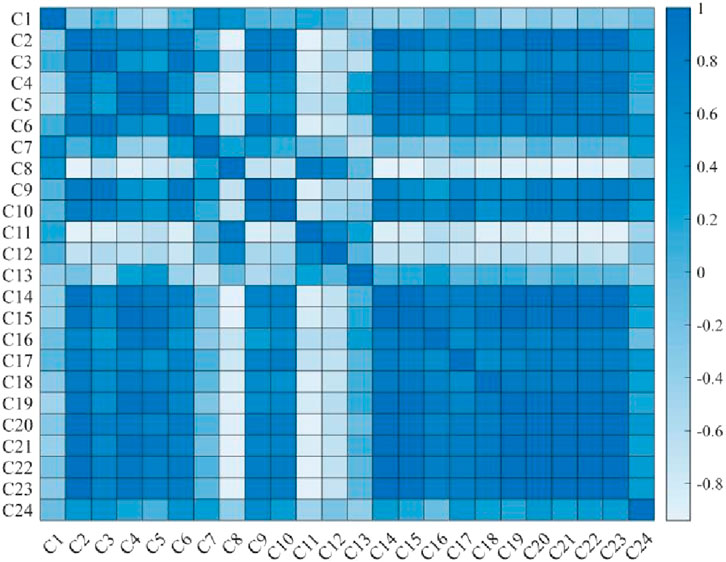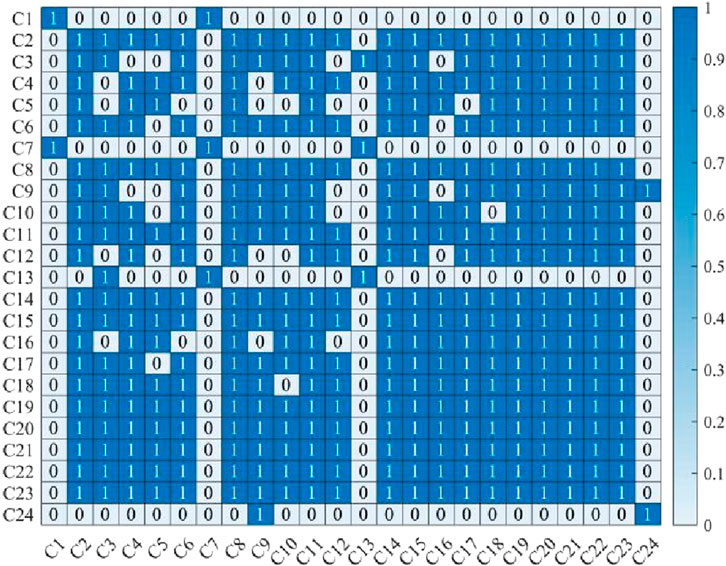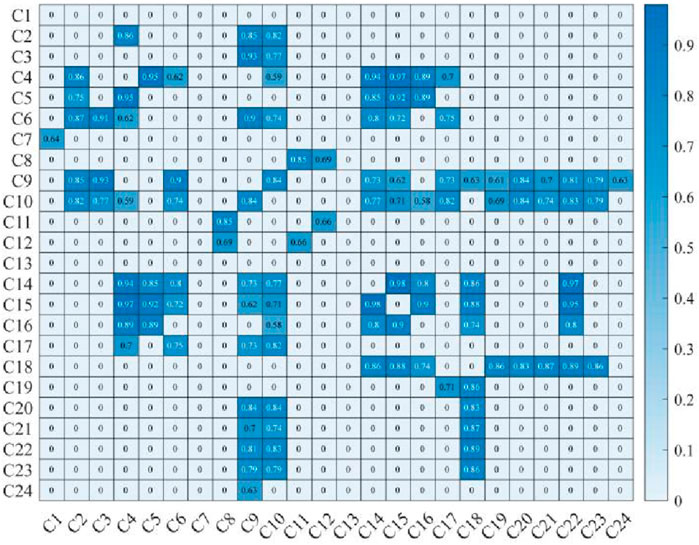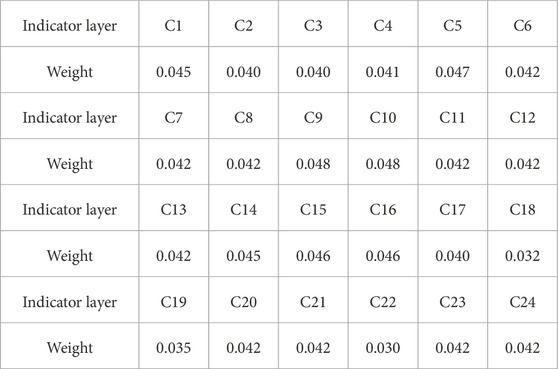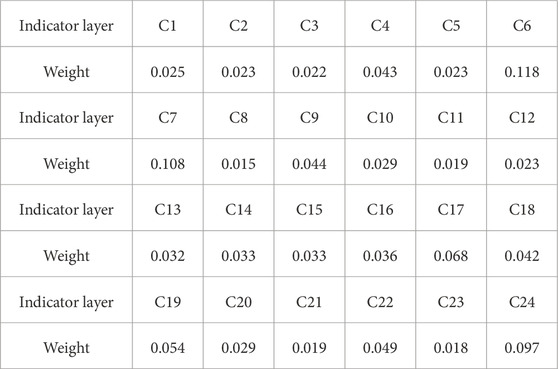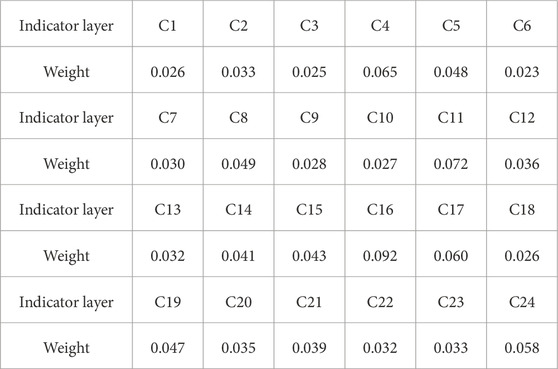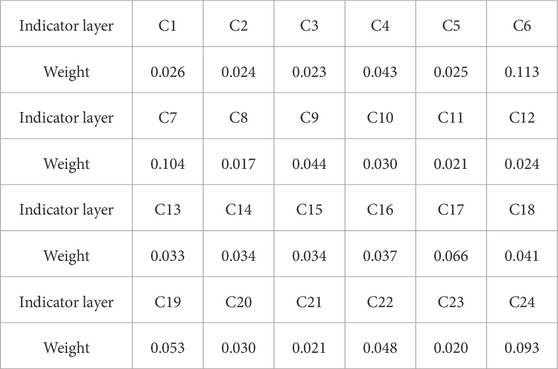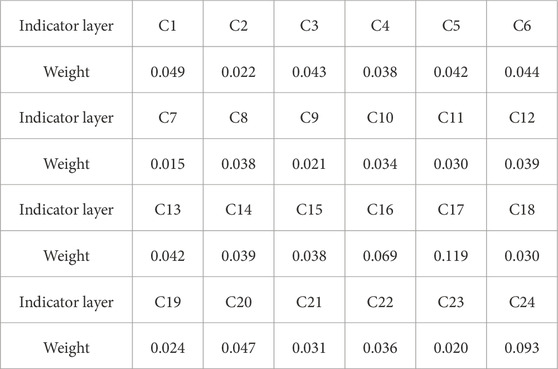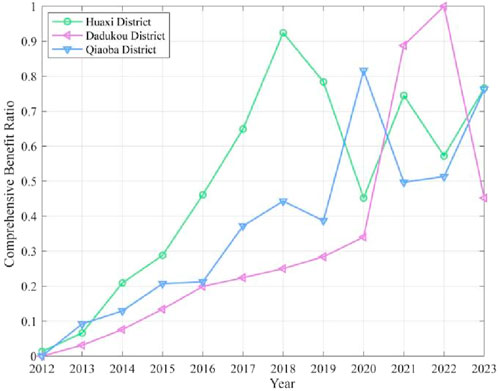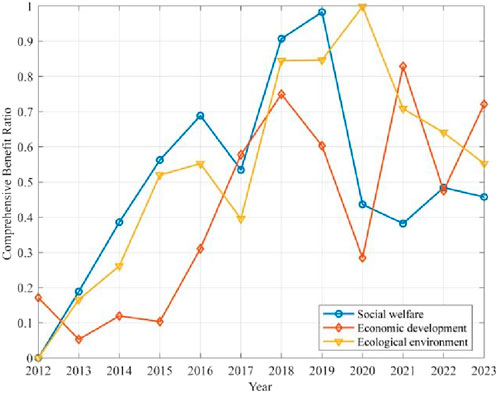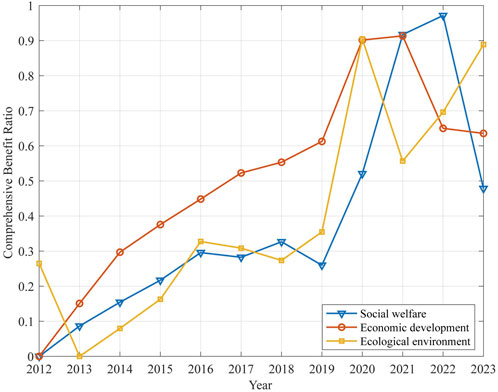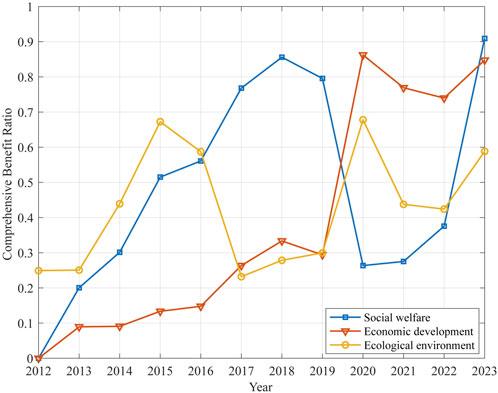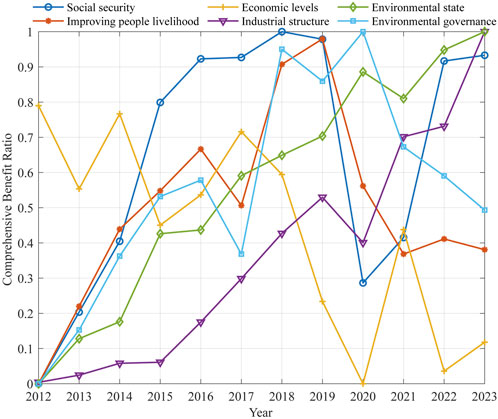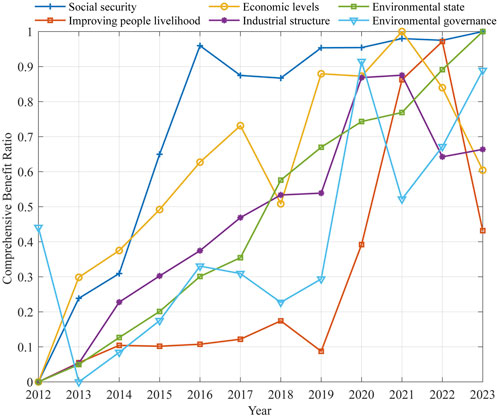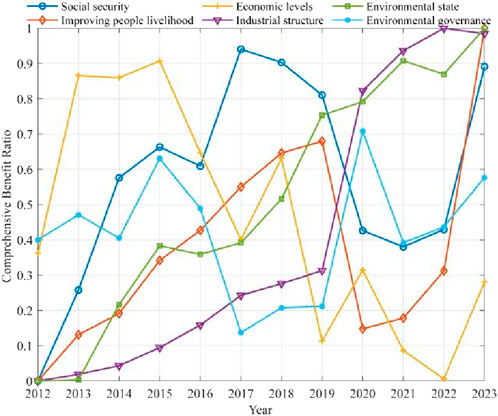- 1School of Cultural Communication and Design, Chongqing University of Arts and Sciences, Chongqing, China
- 2School of Architecture and Urban Planning, Chongqing University, Chongqing, China
- 3School of Mechanics and Civil Engineering, China University of Mining and Technology, Xuzhou, China
Introduction: Since the beginning of the twenty-first century, with the depletion of resources, the decline of industries and the impact of emerging technologies, old industrial bases have faced problems such as an aging economic structure, weak growth, deterioration of the ecological environment, and the backwardness of public facilities, which have severely constrained the sustainable development of cities. Although the government has continued to invest a large amount of resources to promote the transformation of old industrial zones, there are significant differences in the effectiveness of the transformation between regions from a national perspective, with some areas achieving significant results and others still facing economic and social difficulties.
Methods: This study aims to construct an evaluation index system for the transformation performance of old industrial cities and use a combination empowerment model based on the game-theoretic combined weighted approach and the GRA-VIKOR-coupling coordination degree comprehensive evaluation model. Specific regions, including the Dadukou District in Chongqing, the Huaxi District in Guiyang, and the Baqiao District in Xi’an, were selected as sample cases to diagnose the transformation performance and evolutionary characteristics of coupled coordinated development in old industrial cities from 2012 to 2023, and an in-depth analysis of the issues encountered during the transformation process was conducted.
Results: The results of the study found that: (1) Overall, the comprehensive transformation performance of the three old industrial cities exhibited a fluctuating upward trend during the study period, verifying the positive impact of China’s policy support and industrial structure optimization for old industrial cities. (2) According to the results of the coupling coordination degree, the overall trend of the coupling coordination level of the three-dimensional system shows an upward trend, and the degree of coordination increases from the “dysfunctional recession zone” to the “coordinated development zone” level.
Conclusion: Based on the above conclusions, this study puts forward targeted policy recommendations that aim to provide valuable references for promoting the high-quality development of old industrial cities.
1 Introduction
Since the beginning of the twenty-first century, with the depletion of resources, the decline of industries and the impact of emerging technologies, old industrial bases have faced problems such as an aging economic structure, weak growth, deterioration of the ecological environment and the backwardness of public facilities, which have severely constrained the sustainable development of cities. The old industrial base is the planned economic period in China for achieving the strategic goal of industrialization and unified planning, with an industrial foundation or a strong dependence on the natural resources of the industrial cluster area, which is mostly located in China’s urban center; thus, a city with an old industrial base is also known as an old industrial city (Song, 2004; Wang, 2007; Yang, 2008). These old industrial bases once played a crucial role in driving and influencing the development of China’s socioeconomy, significantly impacting regional or national economies during industrialization, featuring relatively complete industrial systems with industrial output accounting for a substantial share of regional GDP but predominantly comprising traditional and declining industries in their economic structures. Regarding the type of dominant industry, the old industrial base can be divided into resource-based and manufacturing types; regarding the type of city, the old industrial base can be divided into resource-based old industrial base cities and old industrial base cities (Zhang, 2017). A resource-based old industrial town refers to a type of city that relies on the development and processing of local natural resources to rise and develop. Owing to the impending depletion of internal resources and external pressures from the rise of emerging industries and technological innovation, these cities gradually lost their competitive advantages, resulting in operational challenges for enterprises, mass layoffs and unemployment, the emergence of a new group of impoverished individuals, and the exacerbation of social issues (He and Bi, 2014; Sun, 2014). Old industrial base cities focused mainly on traditional heavy industry and built relatively complete industrial systems, but they have declined in competitiveness due to deep-rooted problems such as falling behind in updating technology and having an irrational industrial structure and institutional rigidity, which have constrained the sustainable development of the local economy (Shang and Zeng, 2014; Wang et al., 2015). There is an urgent need to realize breakthroughs and rebirth through transformation and upgrading.
For this reason, since 2013, the Chinese government has introduced several policies to support the transformation of old industrial zones. For example, the “National Plan for the Adjustment and Transformation of Old Industrial Bases (2013–2022)” integrated the relocation and transformation of old urban industrial zones into the national development strategy for the first time. The two core objectives of this program are “low carbon and environmental protection” and “fostering new industries”, with an aim realizing the economic rejuvenation of old industrial bases through the optimization of industrial structure, the enhancement of innovation capacity and the management of the ecological environment. The plan describes the goal of “comprehensive, coordinated and sustainable development” of the old industrial bases, emphasizes the reshaping of regional competitiveness through spatial reconstruction and industrial upgrading, and lays a solid foundation for the sustainable development of the old industrial bases. Subsequently, the State Council issued the Guiding Opinions on Promoting the Relocation and Rehabilitation of Old Industrial Areas, which further clarified the relocation and rehabilitation pilots of 21 old industrial areas in urban areas across the country, put forward two transformational policies focusing on the support for the renovation and reuse of facilities in old industrial areas and the protection and reuse of industrial heritage, and promoted the remodeling of the functions of the old industrial areas and value regeneration, which provided a concrete practical guideline for the comprehensive revitalization of the 21 old industrial areas. In 2021, the National Development and Reform Commission released the “Implementation Plan for High-Quality Development of Industrial Transformation and Upgrading Demonstration Zones in Old Industrial Cities and Resource-Based Cities”, which marked the evolution of China’s old industrial areas from “adjustment and transformation” to “high-quality development”, emphasizing the promotion of coordinated regional development and green manufacturing development driven by scientific and technological innovation as well as institutional mechanism innovation, with a commitment to achieving high-quality economic development and ensuring a sustainable future for the city.
Since 2013, although the government has continued to invest a large amount of resources to promote the transformation of old industrial zones, there are significant differences in the effectiveness of the transformation between regions from a national perspective, with some regions achieving significant results and others still facing economic and social difficulties. At the same time, in the context of the new era of high-quality development for old industrial cities, clarifying the differences in the revitalization and development of old industrial bases is highly important for the design of differentiated policies. Accordingly, this study constructs a performance evaluation index system for the transformation of old industrial cities from the perspective of sustainable urban development, combining global sustainable development indicators, China’s sustainable development indicators, and the characteristics of China’s old industrial areas and referring to the objectives of the “National Plan for Adjustment and Transformation of Industrial Bases (2013–2022)”. Based on the game-theoretic combined weighted approach and the GRA-VIKOR-coupling coordination degree comprehensive evaluation model, this study selects specific regions, including the Dadukou District in Chongqing, the Huaxi District in Guiyang, and the Baqiao District in Xi’an, as sample cases to diagnose the transformation performance and evolutionary characteristics of coupled coordinated development in old industrial cities from 2012 to 2023, conduct an in-depth analysis of the issues encountered during the transformation process, and provide valuable references for promoting the high-quality development of old industrial cities.
2 Literature review
In recent years, the academic community both in China and elsewhere has extensively studied the performance evaluation of old industrial city transformations, with a primary focus on green transition evaluation, coupling coordination degree evaluation, high-quality development level evaluation, economic transformation effectiveness evaluation, industrial restructuring performance review, and policy impact evaluation. For example, Zhou et al. (2025) constructed a green development evaluation index system based on the DPSIR model, used the Entropy weight method and the TOPSIS model with the obstacle degree model to measure the level of green development and obstacle factors of 17 oil and gas resource-based prefectures in China from 2011 to 2021, and put forward targeted policy recommendations based on the results of the research (Zhou et al., 2025). Zhao et al. (2025) employed the coupling coordination degree model and the obstacle degree model to evaluate the level of coordination among the resource, economic, and environmental systems in coal resource-based cities and proposed targeted policy recommendations by identifying the key obstacles hindering coupled coordinated development (Zhao et al., 2025). Wen et al. (2023) took resource-based cities such as Shaanxi, Gansu, and Ningxia as examples, constructed a comprehensive assessment system containing indicators of industrial diversification and specialization, applied the Entropy weight method and TOPSIS method to analyze the performance of urban transformation from 2010 to 2019, and put forward policy recommendations based on the evaluation results (Wen et al., 2023). Liu et al. (2023) took eight resource cities in Sichuan province as examples, constructed the index system from the dimensions of industrial structure and ecological environment, utilized the shift-share analysis, entropy weight method, and capacity coupling coefficient model to measure the level of industrial structure, the level of ecological environment and the coupling relationship between them, and put forward targeted policy suggestions based on the research results (Liu et al., 2023). Peng et al. (2023) took Yichun city as an example and, on the basis of the entropy weight method and coupling coordination degree model, constructed an economy‒environment‒carbon emission evaluation index system, analyzed the coupling coordination relationships among economic development, environmental quality, and carbon emission levels from 2010 to 2020, and proposed policy suggestions for achieving high-quality economic development (Peng et al., 2023). Wang W. X. et al. (2022) took 115 resource cities at the prefecture level and above in China as an example, constructed a framework for evaluating the green transition performance of resource cities in China, adopted the entropy weight-TOPSIS model to measure the green transition performance of 115 resource cities at prefecture level and above in China from 2009 to 2018, and used the synthetic control method to quantitatively evaluate the effectiveness of sustainable development planning policies at the overall and local levels (Wang Y. et al., 2022). Li et al. (2020) used the coupling coordination degree model to assess the coordinated development status of the socio-economic and ecological environment in 19 resource-based cities in Northeast China as an example and put forward targeted suggestions based on the evaluation results (Li et al., 2020).
In summary, academic research in this field presents the following characteristics. In terms of research themes, previous studies have focused primarily on evaluating single dimensions or specific fields, such as green transformation performance, the degree of coupling coordination, high-quality development levels, and economic performance, but they lack in-depth research from the perspective of an integrated urban sustainable development system, which makes it challenging to assess the transformation performance of old industrial cities comprehensively. In terms of evaluation methods, most previous studies use a single or simple combination of the Entropy weight method-TOPSIS model, AHP method-TOPSIS model or coupling coordination degree model, and few of them have organically integrated the evaluation of the transformation performance of the old industrial cities with the analysis of the level of coordination among systems, which is somewhat deficient in terms of the completeness of the evaluation framework. In terms of weighting methods, prior studies have predominantly utilized either subjective or objective weighting approaches in a single dimension, with combined weighting often being limited to simple linear weighting. Previous studies have predominantly employed the TOPSIS model to rank evaluation objects, but the traditional TOPSIS model overlooks the dynamic correlations among indicators and fails to capture their interaction relationships adequately, potentially leading to discrepancies between the evaluation outcomes and actual conditions (Ren et al., 2018; Zhang et al., 2018). Therefore, based on the theory of sustainable development and the characteristics of China’s old industrial areas, in this study, an evaluation index system for the transformation performance of old industrial cities is constructed that has three dimensions: social welfare, economic development, and the ecological environment. In terms of research methodology, to achieve a more comprehensive evaluation of the transformation performance of old industrial cities, in this study, an integrated evaluation framework that combines the combined weighting model based on game theory and the GRA-VIKOR-coupling coordination degree approach is proposed, old industrial cities (namely, the Dadukou District in Chongqing, the Huaxi District in Guiyang, and the Baqiao District in Xi’an) were selected as sample cases, the evolutionary characteristics of transformation performance and coupling coordination degree of old industrial cities from 2012 to 2023 were diagnosed, and the problems in the transformation process were processed in-depth; additionally, a goal of this study to serve as a reference for promoting the high-quality development of old industrial cities.
3 Evaluation indicator system construction
3.1 Characteristics of old industrial areas
The transformation and development of old urban industrial areas are characterized by long-term and comprehensive development due to the lagging management system and mechanism, industrial decay, an aging economic structure, a declining economic level, insufficient scientific and technological innovation capability, a deteriorating ecological environment, massive population loss, a local labor force characterized by single structure, and many other problems. The meaning of the transformation and development of old industrial areas can be broadly and narrowly defined. In a broad sense, the transformation of old industrial areas in cities refers to the transition from a single economic structure to a diversified economic structure, thus promoting regional economic development through improvements in infrastructure, social security, and ecological governance. In a narrow sense, it entails cultivating emerging industries and upgrading the industrial structure, which in turn leads to changes in urban spatial and land use patterns (Zhang, 2004; Jiang et al., 2010; Guo, 2015). The lagging transformation and development of old industrial areas are influenced by both internal and external factors. The internal factors, including path dependence, institutional mechanisms, strategic development, and industrial structure issues, are often explained by path dependence and lock-in theories, which are used to account for the reasons for the internal decline (Dong and Zhao, 2015). The development of post-industrial cities, the influence of dominant industry lifecycle patterns, and competitive pressure from the external market environment are often used by regional lifecycle theory and competitive advantage theory to explain the influence of external factors (Zhang, 2017). The development of China’s old industrial areas has the following characteristics. First, the development of old industrial areas is integrated with urban development (Li et al., 2016; Tan et al., 2017). For example, the economic structure of old industrial areas tends to be overly dependent on a single industry, and this homogeneity leads to the fragility of the overall economic structure and a weaker ability to resist risk. With the gradual lag in industrial development, the negative impact of old industrial areas on the local economy becomes increasingly significant, and economic growth is severely constrained. Second, the social security system in old industrial areas is relatively weak, the urban function is not perfect, and infrastructure construction is lagging (Yao, 2013; Song and Fan, 2016). For example, the employment structure of old industrial areas is single in nature, and it is difficult for laid-off workers to be re-employed. In the process of enterprise reform, many workers are laid off, and the imperfection of the social security system triggers a series of social problems. In addition, most infrastructures were built in the 1960s, mainly serving industrial areas and their neighboring family areas, resulting in relatively weak urban supporting functions, which make it difficult to meet the needs of modern urban life. Finally, old urban industrial areas are facing serious pollution problems, causing damage to the ecological environment in the process of industrialization, and the ecological environment urgently needs to be treated (Liu et al., 2014; Li and Cao, 2016). For example, there are widespread problems of excessive pollution emissions and noise in old industrial areas, and workers’ living areas are mixed with industrial areas, which has a great impact on the health of residents.
The industrialization and urbanization process in China, which differs from the historical paths of European and American countries, has shown that the development of old industrial cities has gone through the following three stages. (1) During the planned economy period before the reform and opening up (1949–1962), the state planned and constructed numerous old industrial cities centered on heavy industry, which facilitated a balanced layout of productive forces and rapid infrastructure development and provided a solid foundation for the national economy (Fu et al., 2019). (2) During the early stage of nonequilibrium development of reform and opening up (1979–2000), the policy focus of China shifted to prioritizing the development of eastern coastal cities, with economic development centered on improving efficiency (An and Zhang, 2019). During this period, the government issued the “Decision on Several Issues Concerning the Establishment of a Socialist Market Economy System”, marking China’s major transformation from a planned economy to a market economy and the gradual shift of urban functions from being production oriented to being service oriented. However, this strategy led to an imbalance between the economic development of eastern, central and western cities, triggering problems such as the irrational allocation of resources and widening of the economic income gap, and old industrial cities faced serious challenges, marking the initial emergence of the crisis of the old industrial bases. (3) Since the beginning of the new century (2000-present), China has implemented a policy of coordinated regional development, in which China’s old industrial regions are in a critical period of transformation, upgrading, and restructuring (Jin et al., 2018). With China’s reform and opening up and the in-depth development of the market economy, old industrial areas formed during the planned economy era have gradually declined in a post-industrialization context dominated by the service sector. During the process of promoting new urbanization, various issues in these areas have become increasingly evident, including unreasonable urban spatial layouts, mixed residential and industrial zones, severe pollution caused by industrial emissions, and aging public infrastructure. These problems have become critical constraints on urban sustainable development, compelling many old industrial areas to undergo relocation and transformation. Consequently, since 2000, China’s old industrial areas have successively entered three phases: the “relocation, transformation, and revitalization phase” (2000–2012), the “deepening revitalization phase” (2013–2023), and the “high-quality development phase” (2021-present).
3.2 Constructing an evaluation index system based on sustainable development theory
3.2.1 Theoretical basis for the selection of indicators
The concept of sustainable development has deep historical roots, and achieving sustainable development has become the primary common development goal of countries worldwide. The concept of sustainable development first appeared in United Nations documents in 1980. In 1987, the World Environment and Development Commission published a report on “Our Common Future”, which authoritatively explained the concept of sustainable development and was widely recognized by the international community: “It not only meets the needs of contemporary people, but also does not constitute a harmful development of the ability of future generations to meet their needs. Relevant United Nations agencies have been committed to improving the sustainable development indicator system. In 2000, at the Millennium Assembly of the United Nations, heads of state jointly signed the United Nations Millennium Declaration, establishing a set of 21 specific goals and 60 indicators aimed at eradicating poverty and hunger and addressing environmental degradation, health care, and other issues. These indicators have long formed the primary standard for measuring the global sustainable development process, which is used to guide the actual actions of countries in meeting the Millennium Development Goals. The Millennium Development Goals place greater emphasis on addressing social issues, such as poverty and the basic livelihoods of vulnerable groups, and are committed to improving traditional growth models. They were primarily designed as a target system for developing countries (Xian et al., 2020). In September 2015, the United Nations Sustainable Development Summit passed the “Transforming Our World: 2030 Sustainable and Sustainable Development” and proposed a comprehensive, specific development target system that included 17 overall goals and 169 specific goals. The Sustainable Development Goals (SDGs), which represent an evolution and enhancement of the Millennium Development Goals (MDGs) and target all countries globally—both developing and developed—with a more universal approach, prioritizing a comprehensive and coordinated strategic direction for sustainable development by integrating economic, social, and resource-environmental considerations, thus fostering a fair, inclusive, open, integrated, and innovative path toward sustainability (Xian et al., 2021). To monitor and evaluate the implementation of these global SDGs, a group of experts from various countries worldwide subsequently proposed a global guidance framework for SDGs based on the 17 goals and 169 specific goals in 2017.
However, the framework of Sustainable Development Goals is designed primarily at the global and national levels, and direct application to guide the sustainable development of old industrial areas in Chinese cities may face certain limitations. Therefore, international organizations, governments at all levels, and research institutions worldwide have actively engaged in localized research within the global indicator framework system to ensure its adaptability to the application of sustainable development in their respective countries (Guo et al., 2016; Wang and Lan, 2022; Wang W. X. et al, 2022). In summary, this study determines the objectives of the transformation of old urban industrial areas based on the SDGs to better realize the sustainable development of old industrial cities, and provides an in-depth analysis of the difficulties and challenges of old industrial areas in the process of transformation, which is highly important for promoting the high-quality development of old urban industrial areas. As a type of urban area of special significance, old urban industrial areas face enormous problems in the process of sustainable development, and there is an urgent need to transform the international SDG indicator system into an indicator system that is suitable for the development of China’s old urban industrial cities. On this basis, we incorporate the characteristics of the development of old industrial areas and construct a performance indicator system for the transformation of old industrial cities from the perspective of sustainable development.
3.2.2 Constructing an evaluation index system
The academic community has conducted in-depth research on the transformation and development of old industrial cities, achieving relatively mature outcomes in theoretical analysis, evaluation methodologies, and model application. However, most previous studies have focused on a single research dimension, and few scholars have studied the transformation performance of old industrial cities based on a comprehensive system. The previous evaluation indicator system is insufficiently supported by basic theory and suffers from unclear sources of indicator selection, a lack of integration with the SDG framework, and an insufficient consideration of the characteristics of the transformation of old industrial areas, making it difficult to reflect the transformation performance of old industrial cities comprehensively. Therefore, this study adopts the theoretical perspective of sustainable development, integrates the global and Chinese sustainable development indicator frameworks, focuses on the practical needs involved in the sustainable development of old industrial cities, incorporates the characteristics of old industrial area transformation development, considers data availability, and constructs an evaluation index system for the transformation performance of old industrial cities in terms of the three dimensions: social welfare, economic development, and the ecological environment (Table 1).
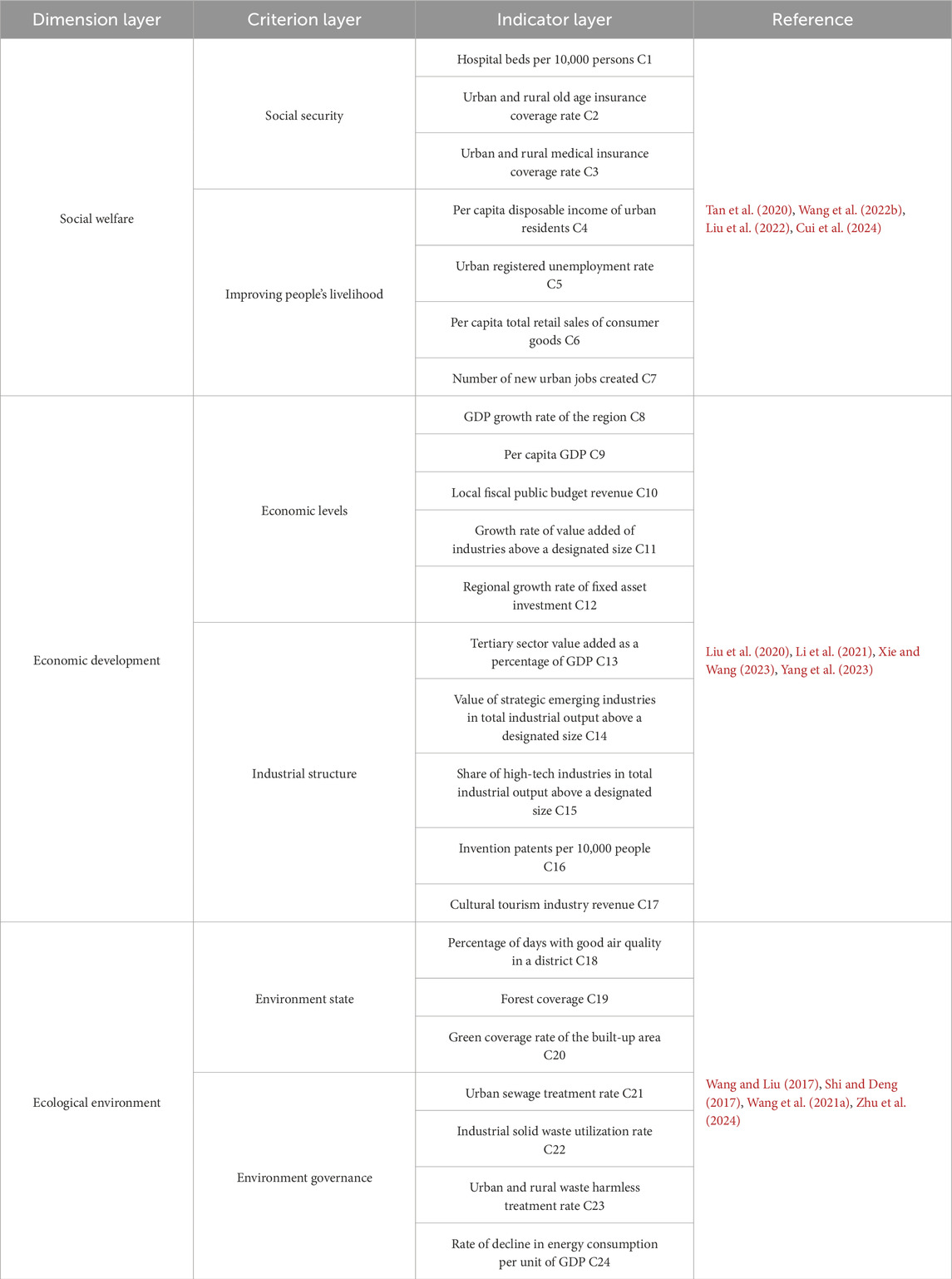
Table 1. Evaluation index system for the transformation performance of old industrial cities based on sustainable development theory.
The indicator system construction process of this study is as follows (Figure 1). First, fully drawing on existing research results, the theory of sustainable development was chosen as the theoretical basis for the construction of the indicator system. The international sustainable development indicators database (SDGs), combined with China’s sustainable development goal planning and referring to China’s sustainable development indicators system, was used as the basis for indicator selection. The database above was summarized and analyzed to construct a database of indicators of sustainable development in cities. Second, on the basis of the authority and universality of the indicator sources and the reliability of the data sources, the indicator database was screened to remove the indicators with unreliable data sources, eliminate the indicators that are not suitable for measuring the sustainable development of Chinese cities, and, at the same time, remove the indicators with the same meaning to establish a database of the basic indicators for the sustainable development of Chinese cities. Finally, authoritative experts in the field were invited to revise, evaluate, and select indicators that are suitable for the sustainable development of China’s old industrial cities by combining the characteristics of the development of old industrial areas and through in-depth discussions in several rounds of consultation meetings. On this basis, characteristic indicators related to the transformation of old industrial zones were supplemented to finally form a scientific, complete, and targeted indicator system.
The social welfare dimension indicators primarily reflect the extent of social security improvement and the improvement in residents’ living conditions during the transformation and development of old industrial cities. These indicators correspond to the following international sustainable development goals: SDG1 (No Poverty), SDG3 (Good Health and Wellbeing), SDG8 (Decent Work and Economic Growth), and SDG10 (Reduced Inequalities). In the transformation process of old industrial cities, the adjustment of industrial structures has resulted in some workers facing layoffs and re-employment challenges, which not only impact the stability of residents’ lives but may also trigger a range of social risks. Therefore, to comprehensively measure the performance of the social welfare dimensions in the transformation of old industrial cities, in this study, criterion layer indicators are chosen for the dimensions of social security and residents’ life improvement. The social security criterion layer covers three indicators: hospital beds per 10,000 persons, the urban and rural old age insurance coverage rate, and the urban and rural medical insurance coverage rate. These indicators reflect the sufficiency of the city’s medical resources as well as the level of residents’ pensions and medical insurance, serving as key measures of the city’s social security capacity. The improving people’s livelihood criterion layer covers four indicators: the per capita disposable income of urban residents, the urban registered unemployment rate, the per capita total retail sales of consumer goods, and the number of new urban jobs created. These indicators can be used to effectively assess changes in residents’ income levels, employment status, and consumption capacity, and are key indicators for measuring improvements in residents’ living standards.
The economic development dimension indicators primarily reflect the economic performance and industrial transformation during the transformation and development of old industrial cities, with the corresponding international sustainable development goals being SDG8 (Decent Work and Economic Growth), SDG9 (Industry, Innovation, and Infrastructure), and SDG11 (Sustainable Cities and Communities). In the process of transforming old industrial cities, accelerating the relocation and upgrading of old industrial zones as well as industrial upgrading promotes the transition of the regional economy from a single traditional industry to an emerging composite industry, thereby driving economic growth and creating employment opportunities. At the same time, increasing the city’s economic strength and competitiveness and providing better living conditions for residents have become core objectives of the transformation of old industrial cities, which necessitates paying attention to improving the city’s economic efficiency and optimizing the industrial structure during the transformation process. Therefore, to comprehensively measure the performance of the economic development dimension in transforming old industrial cities, this study selects the criterion layer indicators of economic level and industrial structure. There are five economic level criterion layer indicators: the GDP growth rate of the region, the per capita GDP, the local fiscal public budget revenue, the growth rate of value added of industries above a designated size, and the regional growth rate of fixed asset investment. These indicators can be used to comprehensively reflect a city’s economic scale, growth rate, fiscal strength, and overall level of industrial development, and serve as the core indicators for measuring the effectiveness of economic transformation in old industrial cities. There are five criterion layer indicators: the tertiary sector value added as a percentage of GDP, the value of strategic emerging industries in total industrial output above a designated size, the share of high-tech industries in total industrial output above a designated size, the number of invention patents per 10,000 people, and the cultural tourism industry revenue. These are key indicators for measuring the quality of industrial upgrading and transformation of old industrial cities, as they can be used to examine in depth the degree of diversification, high-endization, and innovation of the city’s industrial structure.
The ecological environment dimension indicator primarily reflects the effectiveness of ecological environment management after the transformation of old industrial cities, and the corresponding international sustainable development goals are SDG6 (Clean Water and Sanitation), SDG11 (Sustainable Cities and Communities), SDG12 (Responsible Consumption and Production), and SDG13 (Climate Action). The problems of environmental pollution (e.g., air pollution, water pollution, and soil pollution) and ecological damage accumulated during the long-term development of old industrial cities have seriously constrained the sustainable development of the cities. Therefore, this study selects the criterion layer dimension indicators of environmental status and environmental governance to measure the effectiveness of the transformation of old industrial cities in terms of ecological and environmental governance. The environmental status criterion layer covers three indicators, including the percentage of days with good air quality in a district, the forest coverage, and the green coverage rate of the built-up area. These are the core indicators for measuring the ecological environment quality after the transformation of old industrial cities, directly reflecting the degree of improvement achieved by the transformation on regional environmental quality, and they are important indicators for evaluating the effectiveness of ecological construction in old industrial cities. The environmental governance criterion layer covers four indicators: the urban sewage treatment rate, the industrial solid waste utilization rate, the urban and rural waste harmless treatment rate, and the rate of decline in energy consumption per unit of GDP. These indicators are key to ensuring the ecological and environmental performance of the transformation of old industrial cities, reflecting the strength of environmental governance and the efficiency of resource utilization, and are important indicators for measuring the environmental governance capacity and sustainable development level of old industrial cities. Through the use of these indicators, the effectiveness of the transformation of old industrial cities in terms of environmental quality improvement and ecological governance can be assessed in depth, providing a reference for the transformation of other old industrial cities.
4 Research methods
To evaluate the transformation performance of old industrial cities more comprehensively, in this study, a comprehensive evaluation framework is proposed that is based on the combined weighting model based on game theory and the GRA-VIKOR-coupling coordination degree approach, as shown in Figure 2. The evaluation process is as follows. First, the combined weighting model integrates the improved DEMATEL method and the Entropy weight method, further combining subjective and objective weight results using the NASH equilibrium game model to determine the optimal combination coefficient and achieve a more scientifically and reasonably weighted distribution. Second, with respect to the comprehensive evaluation method, this study constructs a comprehensive assessment framework of the GRA-VIKOR-coupling coordination degree method to comprehensively assess the transformation performance of old industrial cities and the degree of coupling coordination. Meanwhile, this study introduces the gray relational coefficient to capture the correlation among indicators, compensating for the deficiency of the traditional VIKOR model in the analysis of data correlation, and it conducts a comprehensive ranking on this basis. Finally, the coupling coordination degree model is applied to assess the levels of coordinated development among the social welfare, economic development, and ecological environment systems. Overall, the comprehensive evaluation framework constructed in this study progresses from combined weighting to scheme ranking and further to intersystem coordination assessment, meaning that the framework is able to assess the transformation performance of old industrial cities in a more comprehensive and precise manner, and it contributes a solid theoretical foundation and technical support for realizing the goal of sustainable urban development.
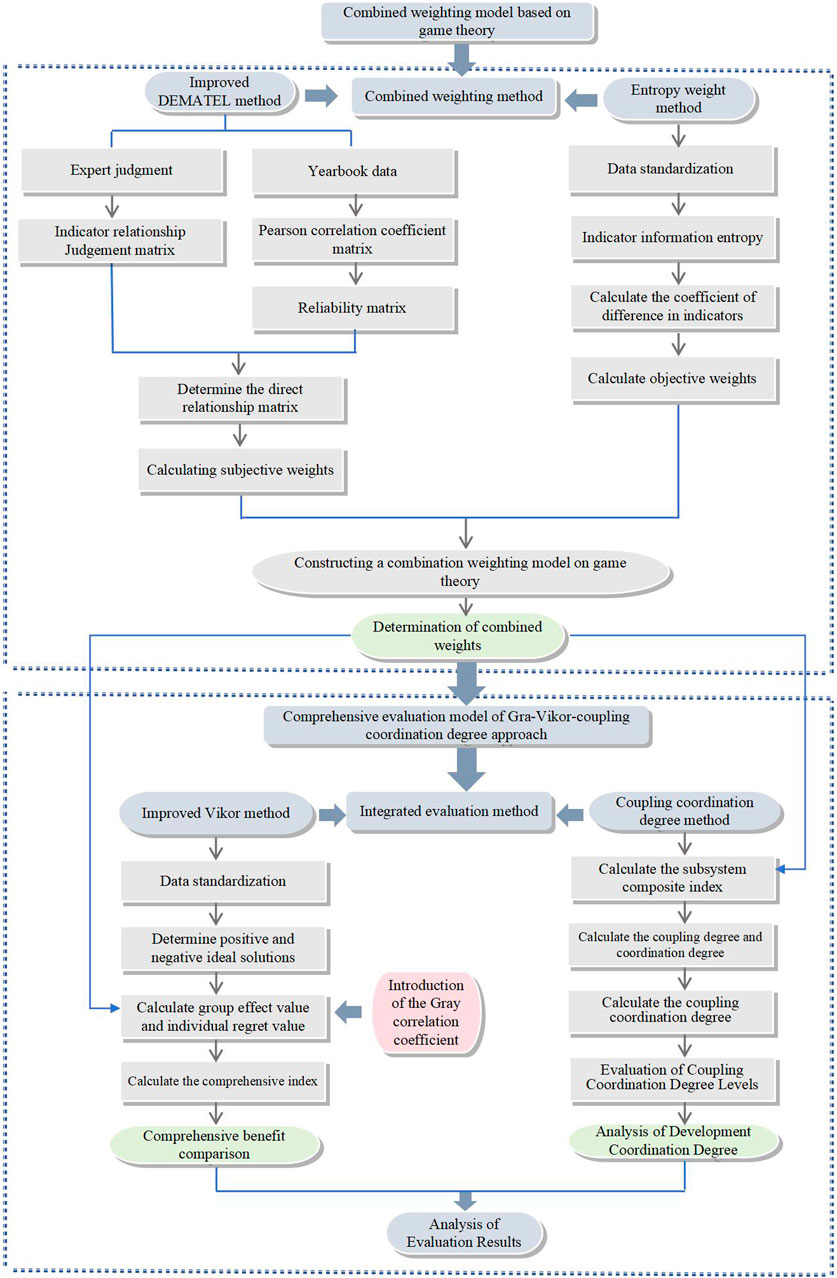
Figure 2. Comprehensive evaluation process of the transformation performance of old industrial cities.
4.1 Construction of the combined weighting model based on game theory
4.1.1 Improved the subjective empowerment model of the DEMATEL method
The performance evaluation of urban old industrial cities is based on a complex system involving social welfare, economic development, and the ecological environment, and it may be influenced directly by single factors or indirectly by the combined effects of multiple dimensions. The DEMATEL method is a system analysis method based on graph theory and matrix tools, and it can be applied to more complex systems. It can quantitatively analyze the intrinsic relationships among the indicators and factors in a complex system through the knowledge and experience of experts, identify the degrees of mutual influence among the indicators, transform the interactions among the indicators into weights, and provide a scientific basis for the allocation of weights of the evaluation indicators (Niu and Wu, 2023).
However, the traditional DEMATEL method has certain limitations. It is susceptible to the subjective judgments of experts, which may lead to biases in assessing indicator correlations and inaccuracies in quantifying relationships, and it struggles to capture the complexity and dynamic nature of systems fully, thus affecting the reliability of evaluation results (Zhang et al., 2019; Fan and Gu, 2021). Therefore, this study introduces statistical yearbook data, quantifies the relationships among indicators, obtains the correlation coefficient matrix and significance matrix, and objectively verifies expert judgments. Second, by combining expert judgments and data validation, the direct relationship matrix is determined, and the influence and objective weights of the indicators are calculated. The specific steps are as follows:
4.1.1.1 Collect expert judgments
Expert judgment is applicable to the preliminary study of a project, with the advantages of being able to make effective recommendations when less information is available and the disadvantage of being able to make only qualitative evaluations, not quantitative analyses. To fully exploit the advantages of expert judgments while avoiding their disadvantages, this study uses expert evaluation as a supplement to the yearbook data, which helps to remove correspondence that is significant in the data but does not actually exist. To avoid any difficulty in judging the strength of relationships, the experts in this study judged only whether the index relationship is present or not. This study invited multiple industry experts to participate in the decision-making process and adopted the Delphi method to reach a consensus. The final consensus formed the expert judgment matrix, as shown in Formula 1.
In this matrix,
4.1.1.2 Calculate the initial relation matrix
Using SPSS software, the paper enters the statistical yearbook data into SPSS software, the pairwise relationships between the weights of the second- and third-level indicators are calculated, and the Pearson correlation coefficient matrix P, as in Formula 2, and the reliability matrix R, as in Formula 3, are obtained. In the matrix,
In the matrix,
4.1.1.3 Calculate the direct relationship matrix
The calculation of the Pearson correlation coefficient for two sets of indicators does not necessarily imply a relationship between them, as it is necessary to first consider whether the Pearson correlation coefficient is significant. If the corresponding p value is greater than 0.05, then the relationship between the indicators is not significant, which means that the calculated Pearson correlation coefficient is not reliable and should be removed from matrix P. Furthermore, even if there is a significant Pearson correlation between the two indicators, it is not entirely certain that they interact. The presence of data that increase and decrease over time in longitudinal data results in a significant correlation between two sets of data that are not actually related. To prevent this phenomenon from affecting the study data, relationship values that show a significant correlation but are not actually related should be removed. In this study, the corresponding positions of matrices P, R and J are multiplied to obtain the quantitative values of the direct impact between the indicators, and matrix I is shown in Formula 4.
In the matrix,
4.1.1.4 Construct the standardized direct relation matrix
Take the direct influence quantification value matrix I as matrix
In the matrix, the values in matrix I are used to assign the
4.1.1.5 Construct the direct correlation and indirect correlation matrix
Convert matrix
4.1.1.6 Calculate the influence ability of indicators
Formula 7 is used to calculate the values of R + C and R-C, where R is the sum of the data in each row of matrix
4.1.1.7 Calculate the indicator weight
Through the previous calculation, we obtain the R-C value for each of the indicators. The positive R-C value indicates that the indicator is an influencer, and a negative R-C value indicates that the indicator is influenced. Although the value of R-C represents the importance of the index, in the transformation benefit index model, positive and negative weights represent the direction of the role, and positive weights indicate that the efficiency of the high industrial area of the indicator increases, whereas negative weights indicate that the transformation benefit of the industrial area decreases as the index increases. To change the meaning of this difference, this study first treats the R-C values of each index as positive. Through Formula 8, the R-C value of all indicators is set to positive values, and the weight value
4.1.2 Entropy method the objective weighting model
The evaluation of the transformation performance of old industrial cities is a complex systematic problem involving multidimensional and multifactor coupling, and the scientific allocation of indicator weights needs to consider expert experience and the objective intrinsic law of the data. As the DEMATEL method is a subjective empowerment method, it excessively relies on the subjective judgments of experts, which may lead to strong subjectivity in weight allocation and a lack of objectivity. The Entropy weight method, as an objective empowerment method, determines weights based on information from the data themselves and quantifies the degree of dispersion of the index data, which compensates for the influence of the subjective weighting method of the DEMATEL method on the judgment of the weights and improves the objectivity and reliability of the evaluation results (Yang et al., 2019). Therefore, this study introduces the Entropy weight method in combination with the DEMATEL method to ensure that the weight allocation reflects both experts’ judgments of causality and the objective differences in the data themselves. The calculation steps are as follows:
4.1.2.1 Standardize the matrix
First, when the Entropy weight method is applied, the data need to be standardized. Considering that there are both positive and negative indicators among the evaluation indicators, according to Formulas 10, 11, the positive and negative indicators are standardized.
In the formula,
4.1.2.2 Calculate the information entropy of the index
First, calculate the feature weight
In the formula, n is the number of years,
4.1.2.3 Calculate the coefficient of variation in the indicators
According to Formula 14, the coefficient of variation
In the formula,
4.1.2.4 Calculate the weight vector
Formula 15 is used to calculate the weight vector
In the formula,
4.1.3 Combined weighting model of the Nash equilibrium game
There are limitations in the traditional weighting method. The subjective weighting method is easily influenced by the knowledge structure of experts, industry background and cognitive differences, resulting in deviating from objective reality. The objective weighting method is based on historical data; when using this method, it is difficult to foresee the future dynamic changes, and it is easy to ignore the policy orientation and strategic needs. The combined weighting model of the Nash equilibrium game can take the subjective weights obtained by the improved DEMATEL method and the objective weights obtained by the Entropy weight method as the two decision-making subjects of the game (Xu et al., 2024). By calculating the optimal solution of the subjective and objective weights, the weights obtained by the two methods are balanced to obtain a more balanced result and improve the scientificity of the index weight allocation (Li et al., 2018). Therefore, this study adopts the combined weighting method of game theory to optimize the combination of the subjective weights of the DEMATEL method and the objective weights of the Entropy weight method and to calculate the optimal solution of the subjective and objective weights, providing more accurate weights for the subsequent comprehensive evaluation model of the GRA-VIKOR-coupling coordination degree method. The calculation steps are as follows:
(1) First, the basic weight vector set is established. The weights obtained via the DEMATEL method and EWM are
In the formula,
(2) Using Formula 19, the linear coefficients of the two groups of weight vectors
(3) According to the principle of differential, the first-order derivative condition for taking the minimum value using Formula 19 and Formula 20 is:
(4) The optimal linear combination coefficients
4.2 Construction of an evaluation model based on the GRA-VIKOR-coupling coordination degree method
The transformation of old industrial cities is a complex, systematic project involving multiple dimensions, such as economic development, social welfare, and the ecological environment. During this process, the developmental trajectories of different old industrial zones in various cities may vary significantly. To obtain a comprehensive understanding of the dynamic changes in old industrial cities in each year of the transformation process, it is necessary to comprehensively consider the performance of different dimensions and rank the performance of each year of the transformation process. By sorting, the annual trend of the transformation performance of old industrial cities can be visualized, which can not only help policymakers understand the stage-by-stage results and problems in the transformation process but also provide a basis for future policy formulation and resource allocation. The VIKOR method, a multicriteria decision-making approach, uses comprehensive weights derived from the game equilibrium model to calculate the minimum distance, maximum deviation value, and comprehensive utility value of each scheme relative to positive and negative ideal solutions, thus providing a compromise ranking for complex systems (Chen and Ma, 2023).
However, the traditional VIKOR method has certain limitations and does not consider the intrinsic correlation between the indicators when calculating the distance between each scheme and the ideal solution, thus reducing the accuracy of the evaluation results (Zhao and Yang, 2023). In contrast, the core advantage of gray relational analysis (GRA) is that it can fully explore the correlation between sample data, quantify the dynamic correlation between indicators by calculating the gray relational coefficients between each scenario and the ideal solution, and compensate for the shortcomings of the VIKOR model’s insufficient analysis of data correlation (Xiang and Cao, 2025). Consequently, this study integrates the GRA and VIKOR methods to construct a comprehensive GRA-VIKOR evaluation framework, which enhances the scientific rigor and reliability of the evaluation outcomes. The specific steps are as follows:
4.2.1 GRA-improved VIKOR model
4.2.1.1 Calculate the weighted normalization matrix
Owing to the complexity of the data for the evaluation indicators, the factors of the indicators have different dimensions and magnitudes. Therefore, all the indicators need to be standardized according to Formulas 10, 11 to obtain the standardized matrix Y. In the standardized matrix, the best and worst values of the indicators for the positive and negative ideal solution schemes refer to the maximum and minimum values of the indicator data, respectively.
4.2.1.2 Determine the positive and negative ideal solutions
Based on the attributes of the indicators, sets of positive and negative ideal solutions are constructed. Here,
4.2.1.3 Determine the gray relational coefficients
The gray relational coefficients are introduced, and the gray relational coefficients of the annual data sequence of each evaluation object are calculated with the positive and negative reference solutions using Formulas 26, 27.
The discrimination coefficient is
4.2.1.4 Calculate the group utility value and individual regret value based on the GRA-VIKOR method
Based on the principles of the VIKOR method, the group utility value
In the formulas, the group utility value
4.2.1.5 Calculate the comprehensive benefit ratio based on the GRA-VIKOR method
Using Formula 30, the comprehensive benefit ratio
In this formula,
4.2.2 Coupling coordination degree model
Although the evaluation model of the GRA-VIKOR method can compare the performance of the transformation of old industrial cities each year, it is difficult to observe the degree of internal coordination. For example, there may be situations in which, for example, a certain year has a high ranking in transformation performance but the development among its systems is unbalanced. The coupling coordination degree model can comprehensively assess the degree of mutual balance and coordination among different systems so that the evaluation results of the transformation performance of old industrial cities not only reflect the single performance level but also reveal the level of synergistic development among systems (Li et al., 2020). Therefore, this study introduces the coupling coordination degree model to quantify the level of coordinated development among the systems of social welfare, economic development and the ecological environment to evaluate the transformation performance of old industrial areas in a more comprehensive manner and to improve the comprehensiveness and scientificity of the evaluation results.
4.2.2.1 Calculate the coupling degree
Formula 31 is used to calculate the couple degree of the indicators.
In the formula, B represents the coupling degree of the indicator, and the value range is [0, 1]; a larger value of B indicates a higher degree of coupling between the two.
4.2.2.2 Comprehensive coordination index
The comprehensive coordination index among the three systems is calculated using Formula 32.
In the formula, C represents the comprehensive coordination index among the social welfare, economic development, and ecological environment systems. The larger the value of C is, the better the development status of the systems.
4.2.2.3 Degree of comprehensive coordination
The comprehensive coordination index can illustrate the strength of the interaction between systems, although the study of the relationships among social livelihood, economic development and the ecological environment also needs to pay attention to the level of their coordinated development and more accurately evaluate the degree of comprehensive coordination among the three systems. Its calculation formula is as follows:
In this study, with reference to related research (Wang T. et al., 2021; Zhang and Han, 2022), the level of coupling coordination among the three systems of social welfare, economic development and the ecological environment is divided into three major intervals, namely, the dysfunctional recession zone, overcoordinated zone, and coordinated development zone, and the level of coupling coordination degree is classified into ten grade types from high to low, as shown in Table 2.
5 Empirical analysis
5.1 Research objects and data sources
This study is based on the “National Old Industrial Base Adjustment and Rehabilitation Plan (2013–2022)” and the “21 pilot old industrial areas for relocation and transformation initially determined by the National Development and Reform Commission”, and it selects the Dadukou District of Chongqing city, the Baqiao District of Xi’an city, and the Huaxi District of Guiyang city as the sample cases for research. These three cities are traditional manufacturing bases in the southwest region, with similar historical backgrounds and stages of development, and they were included in the first batch of national policy-supported transformation demonstration sites, the effectiveness of which is highly important for the revitalization of other old industrial cities in China. These sample areas were once dominated by traditional heavy industry and now face common problems such as a single industrial structure, backward technology, serious environmental pollution, aging infrastructure, an imbalance in the employment structure, and inefficient industrial land use, making the need for transformation very urgent. Specifically, the Dadukou District in Chongqing city, which was once dominated by traditional iron and steel smelting and chemical production, is currently transitioning into a high-quality living experience zone that integrates premium residential areas and ecological leisure tourism, as well as an industrial cluster focused on modern trade, the headquarters economy, creative leisure, information services, and urban industries. The Huaxi District in Guiyang city, dominated by traditional mechanical manufacturing, is now transforming in terms of industrial heritage protection and utilization, cultural creativity, an e-commerce industry cluster, a modern service industry function center, and an eco-green headquarters new city. The Baqiao District in Xi’an city, once driven primarily by the traditional textile industry, is now evolving into an ecological new town of Xi’an’s International Metropolis, with a focus on trade and logistics, cultural creativity, urban real estate, and ecological tourism.
The statistical data utilized for this study were obtained from the Regional Statistical Yearbook, the Regional Statistical Bulletin on National Economic and Social Development, the Regional Government Report, and, for some of the environmental data, the Environmental Quality Bulletin of the cities. To ensure the accuracy of the assessment of the transformation benefits of old industrial cities, the data are selected according to the following principles: first, according to the “National Industrial Base Adjustment and Transformation Plan (2013–2022)” and the release of the first national demonstration sites, 2012–2023 is selected as the time scale for the study to cover the entire cycle of policy implementation. Second, to address the problem of a small portion of missing data, linear interpolation is used, or the average value of adjacent years is used as a substitute.
5.2 Calculation results of combined weighting based on game theory
5.2.1 Calculation results of the improved DEMATEL method
This study takes the Dadukou District of Chongqing city as an example to present the calculation results. First, through five rounds of the Delphi method and structured interviews, the experts were organized to make binary judgments on the causal relationships between indicators (1 indicates existence, 0 indicates nonexistence), and the expert judgment matrix was obtained (Figure 3). A total of 10 senior experts were invited to participate in the consultation of this study; their expertise covered a wide range of fields such as practice and theoretical research, thus ensuring a high degree of representativeness and authority. Specifically, three experts were senior chief architects from well-known domestic design institutes, specializing in old industrial area renovations with over 10 years of extensive practical experience. Another three experts came from government departments, including a senior engineer from the Planning Bureau, the director of a subdistrict office, and the deputy director of the Urban Renewal Office, all of whom possessed substantial expertise in policy formulation and implementation. Additionally, four experts were professors from key domestic universities whose research focused on sustainable development strategies for urban old industrial areas. Second, using statistical yearbook data, the Pearson correlation coefficient matrix (Figure 4) and the reliability significance matrix (Figure 5) were calculated using Formulas 2, 3. In particular, the Pearson correlation coefficient matrix (Figure 4) reveals the strength of linear correlation between the indicator data, while the reliability significance matrix (Figure 5) verifies the reliability of the correlation coefficients through the significance level (p-value), where coefficients with significance levels below 0.05 are considered statistically significant, indicating the existence of a significant linear relationship between the corresponding indicators. Then, the expert judgment matrix is combined with Pearson correlation coefficient matrix and reliability significance matrix to get the direct influence relationship matrix by Formula 4, and the results are shown in Figure 6. Finally, through Formula 9, the objective weight of each indicator is calculated, and the calculation results are shown in Table 3. The larger the weight value is, the more important the role played by the indicator in the evaluation system.
5.2.2 Calculation results of Entropy weight method
Based on the statistical yearbook data of each district, taking the Dadukou District of Chongqing city as an example, the data were standardized using Formulas 10, 11 to ensure the comparability of indicators with different dimensions. Using Formulas 12–15, the information entropy values of each indicator were subsequently calculated, the coefficient of variation of each indicator was determined, and a weight vector was ultimately constructed to obtain the objective weighting results (Table 4).
5.2.3 Calculation results of the Nash equilibrium game-theoretic combined weighting model
On the basis of the Nash equilibrium combined weighting model, using Formulas 16–22, taking the Huaxi District, Dadukou District, and Baqiao District as examples, the optimal comprehensive weights of each indicator were calculated, as shown in Tables 5–7.
5.3 Evaluation results and analysis based on the GRA-VIKOR-coupling coordination degree method
5.3.1 Comprehensive performance evaluation results and analysis
Based on the GRA-VIKOR model Formulas 23-27, with the three regions serving as evaluation units, the performance results of the evaluation objects across different dimensions from 2012 to 2023 were calculated. Overall, the comprehensive transformation performance of the three old industrial cities exhibits a fluctuating upward trend, transitioning from a lower level to a higher level, which verifies the positive impact of policy support and industrial structure adjustment on old industrial cities in China and indicates that the transformation of these three old industrial cities has achieved significant positive outcomes (Figure 7). According to the calculation results (Figure 7), the three old industrial cities show different trends of change in the transformation process, which can be summarized in the following three stages.
The first stage is the slow growth period (2012–2015), which is the early stage of the transformation of old industrial cities, and the comprehensive performance of the transformation of the three old industrial areas shows a steady and slow growth trend, driven by national policy support. In this stage, the comprehensive performance of the Huaxi District gradually increased from 0.013 in 2012 to 0.288 in 2015; the comprehensive performance of the Dadukou District gradually increased from 0.000 in 2012 to 0.134 in 2015; and the comprehensive performance of the Baqiao District increased from 0.000 in 2012 to 0.207 in 2015 (Figure 7). From the perspective of the dimension layer (Figures 8–10), the economic development levels of the Huaxi District and Baqiao District are relatively lagging, while the ecological environment level of the Dadukou District is relatively lagging. Furthermore, from the perspective of the criterion layer (Figures 11–13), the lagging economic development performance of the Huaxi and Baqiao Districts is caused by the slow growth of industrial structure performance, whereas the lagging ecological environment development level of the Dadukou District is caused by the double influence of the environmental state and the level of environmental governance. The causes of this phenomenon can be attributed to several main factors. First, during the early stages of transformation, the government successively implemented a series of supportive policies aimed at promoting the comprehensive, coordinated, and sustainable development of old industrial bases, which provided effective guidelines for the transformation and development of old industrial cities. For example, in March 2013, the promulgation of the “National Old Industrial Base Adjustment and Transformation Plan (2013–2020)” made the relocation and transformation of old urban industrial zones an important part of socio-economic development for the first time; furthermore, it described the plan to implement low-carbon policies and environmental protection, create new industries, and push forward the comprehensive, coordinated and sustainable development of old industrial bases. In March 2014, the State Council issued the Guiding Opinions on Promoting the Relocation and Transformation of Old Industrial Zones, which explicitly requires accelerating the transformation and transformation of old industrial zones. In July 2014, the National Development and Reform Commission identified 21 old industrial urban areas across the country as the first batch of relocation and transformation pilot zones, proposing the reuse of old factory facilities as well as the protection and transformation of industrial cultural heritage as key policies and encouraging the transformation of abandoned factories for use in new industries. These policies provide strong policy support and financial guarantees for the transformation of old industrial cities, but at the initial stage of transformation, it takes time for the policies to be implemented and for the effects to be realized. On the other hand, the industrial structure adjustment of the old industrial cities is in the initial stage, while new industries are still in the cultivation period and have not yet formed effective support, resulting in insufficient power for economic development. At the same time, long-term industrial development has caused the old industrial cities to accumulate serious environmental pollution problems. There is a mismatch between their pollution control capacity and production capacity, there are high pollutant emissions, and the recovery of the ecological level takes a certain amount of time, which makes the level of ecological and environmental development in the early stage of transformation relatively limited in terms of its contribution to comprehensive performance. In addition, the transformation of old industrial cities faces the challenge of social and livelihood protection. The decline of traditional industries has led to many workers being laid off and unemployed, which requires the provision of job training and re-employment support. In the early stage of transformation, old industrial cities have relatively limited funds and resources for social security and livelihood improvement, which also affects the improvement in social and livelihood performance to a certain extent.
The second stage is the period of rapid growth, which is a stable development period for the transformation of old industrial cities. In this stage, the comprehensive performance of the Huaxi District jumped from 0.461 in 2015 to 0.924 in 2018; the comprehensive performance of the Dadukou District jumped from 0.199 in 2016 to 1.000 in 2022; and the comprehensive performance of the Baqiao District rose from 0.212 in 2016 to 0.443 in 2018 (Figure 7). The reason is that, on the one hand, the strong support of a series of policies for transforming China’s old industrial cities has prompted local governments to increase their investment in and support for transforming old industrial areas. For example, in April 2016, the State Council issued Several Opinions on Comprehensively Revitalizing the Old Industrial Bases in Northeast China and Other Countries, which established the four core tasks of improving the institutional mechanism, promoting structural adjustment, encouraging innovation and entrepreneurship, and safeguarding and improving people’s livelihoods; moreover, this policy described the specific requirements of deepening the reform of state-owned enterprises, advancing the strategic adjustment of the state-owned economic bureau, encouraging the development of the private economy, fostering the new kinetic energy, promoting the transformation and upgrading of the traditional industries, among other requirements. In August 2016, the National Development and Reform Commission issued the “Three-Year Rolling Implementation Plan for Promoting the Revitalization of Old Industrial Bases in the Northeast Region and Other Areas (2016–2018)”, which details several key tasks and major projects around the four core tasks; to promote the overall revitalization and sustainable development of the regional economy, the focus of this policy is organizing the implementation of major innovation projects for the revitalization of old industrial bases, advancing the renovation and relocation of the old industrial areas and independent industrial and mining zones in the urban areas, and continuing the implementation of the shantytown renovation projects. These policies have provided a solid policy basis and a guide for the transformation of old industrial cities, prompting local governments to respond positively and increase their support for old industrial zones in terms of capital investment, infrastructure construction, and industrial guidance, thus creating a favorable policy environment for the transformation and development of old industrial zones. On the other hand, old industrial cities, guided by policies, are actively adjusting their industrial structure, gradually breaking away from their dependence on traditional industries through the development of high-tech industries, modern service industries, and eco-tourism, and realizing rapid economic growth. At the same time, with policy guidance and changes in the market environment, the innovation capacity of old industrial areas has begun to gradually improve. For example, some old industrial cities have made use of their industrial foundation and resource endowment to cultivate and introduce high-tech enterprises and promote industrial upgrading; at the same time, they have vigorously developed modern service industries, such as financial services, information services, and cultural creativity, to increase the proportion of tertiary industries and optimize their economic structure. In addition, the rise of eco-tourism has also brought new development opportunities for old industrial cities, combining industrial heritage with tourism to create special tourism projects, which not only improve the ecological environment but also promote diversified economic development. Meanwhile, in this stage, to improve the level of regional innovation and science and technology and provide strong support for economic development, the government increased its support for scientific and technological innovation and attracted many science- and technology-based enterprises by introducing preferential policies, establishing science and technology parks, and providing research and development subsidies. At this stage, the upgrading of the industrial structure of the old industrial cities has led to rapid economic development, and the proportions of the tertiary industry, high-tech industry, and strategic emerging industries have continued to increase rapidly, which has led to remarkable results in social livelihood, economic development, and ecological environment and has realized the sustainable transformation and stable development of the old industrial cities.
The third stage is the stagnation and decline period, in which the performance of the three old industrial cities in all dimensions fluctuates, but the overall trend is still upward. In this stage, the comprehensive performance of the Huaxi District shows a W-shaped fluctuation trend from 2019–2023. From the dimension layer (Figure 8), social welfare performance peaked at 0.983 in 2019, decreased to 0.382 in the 2020–2021 period, and rebounded to 0.457 in 2023. Economic development performance shows a W-shaped fluctuating trend from the 2019, decreased to 0.285 in 2020 and rebounded to 0.721 in 2023. From 2022 to 2023, the comprehensive performance of the Dadukou District decreased from 1.000 in 2022 to 0.452 in 2023. In terms of the dimension layer (Figure 9), social welfare performance decreased from 0.972 in 2022 to 0.478 in 2023; economic development performance decreased from 1.000 in 2022 to 0.636 in 2023; and ecological environment performance increased from 0.696 in 2021 to 0.889. The comprehensive performance of the Baqiao District shows a U-shaped evolutionary trend from 2019 to 2023. In terms of the dimension layer (Figure 10), social welfare performance decreased to 0.264 in 2020 and then rebounded to 0.909 in 2023; economic development performance showed a W-shaped fluctuation trend, dropping from the 2019 level to 0.740 in the 2021–2022 period and then rebounding to 0.848 in 2023; and ecological performance reached 0.678 in 2020, 0.696 in 2021, and 0.889 in 2023. From the criterion layer (Figures 11–13), the stagnant and declining trend in these three regions is affected mainly by the decline in the performance of social security, the improvement in people’s livelihood, the fluctuation of the performance of the economic level, and the increase in the pressure of environmental governance. The indicator layer is affected mainly by the increase in the registered unemployment rate of urban residents, the decrease in the number of new jobs in urban areas, the decrease in the growth rate of regional GDP, the decrease in the growth rate of regional fixed asset investment, and the decrease in the rate of decline in energy consumption per unit of GDP. The reason is the double contradiction of the external public health and safety emergencies and the lack of endogenous power of urban transformation. In terms of external shocks, the impact of global public health and safety emergencies from 2020–2022 had a multidimensional impact on the development of old industrial cities. First, the economic vitality of the Baqiao and Huaxi Districts was severely impacted, especially because of the significant contraction of consumption and investment as a result of the global public health and safety emergencies. The Baqiao and Huaxi Districts, in particular, are more dependent on consumption and investment due to the high proportion of the tertiary industry, whereas the strategic emerging industries and high-tech industries in these two districts are still in the incubation period, and their risk-resistance capacity is weaker. Second, the attention and financial resources of the government and society were focused on responding to public health and safety emergencies, leading to relative reductions in investment in ecological and environmental management, exacerbating the problem of unemployment caused by the decline of traditional industries and impacting the social security system. From the perspective of internal driving forces, the transformation of old industrial cities has entered a bottleneck phase characterized by the contraction of traditional industries and the insufficient scale effect of high-tech industries. Despite policy-driven increases in the proportion of the tertiary industry in the Huaxi District and Baqiao District, strategic emerging industries and high-tech industries have yet to achieve a significant scale and thus fail to provide robust economic support. On the other hand, old industrial cities in the transformation process also generally face multiple problems, such as insufficient technological innovation capacity, a shortage of high-tech talent, and declining competitiveness in the market, resulting in the attenuation of the kinetic energy of industrial upgrading, which causes the development of old industrial zones to fall into a bottleneck period.
5.3.2 Calculation results and analysis based on the coupling coordination degree method
According to the coupling coordination degree model Formulas 31–33, the coupling and coordinated development levels of systems such as social welfare, economic development and the ecological environment are calculated with the three regions as the evaluation unit and 2012–2023 as the study interval (Figure 14). Comprehensively, it seems that according to the evaluation criteria of the coupled coordination level (Table 2), the coupling coordination level of the social welfare, economic development and ecological environment systems in the three regions shows a continuous upward trend during the study period, and all of them are in a state of good coordinated development (Figure 14). According to the calculation results, the coupling coordination level of the three old industrial cities has gone through three stages of development, namely, the dysfunctional recession zone, overcoordinated zone and coordinated development zone, which indicates that the social welfare, economic development and ecological environment systems have shown a benign and positive promoting effects. These results are related to China’s policy of vigorously promoting the transformation of old industrial cities in recent years, promoting the transformation and upgrading of the industrial structure of old industrial cities, advancing the construction of an ecological civilization, and promoting the coordination of economic development and the ecological environment.
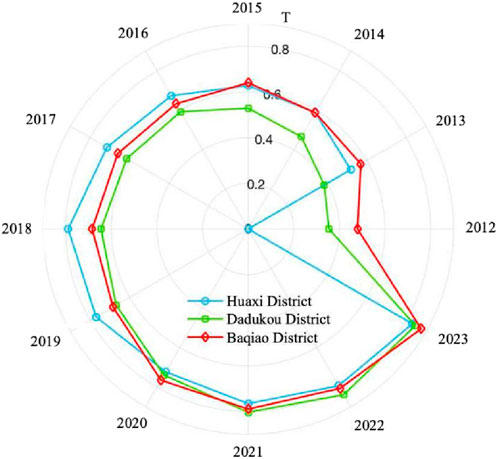
Figure 14. Calculation results of the coupling coordination degree among the three urban subsystems.
The first stage is the stage of dysfunctional recession, where positive interactions have not yet been formed between the social welfare, economic development, and ecological environment systems. During this stage, the coupling coordination degree of the subsystems in the Huaxi District was 0.000 in 2012, which was in an extremely disharmonious state; the coupling coordination degree of the subsystems in the Dadukou District was 0.385 from 2012 to 2013; and the coupling coordination degree of the subsystems in the Baqiao District was 0.479 in 2014. The reason is that the secondary industry in the old industrial cities accounted for a high proportion of GDP, and the industrial structure was homogeneous, with economic growth relying mainly on resource-consuming and labor-intensive industries. Most of these traditional industries were high-energy-consuming and high-pollution industries, and they had a great impact on the ecological environment. The economic development and ecological environment systems constrained each other, making it difficult to form a benign interaction between the ecological environment and economic development, thus seriously restricting the coupling and coordinated development of the three social welfare, economic growth, and ecological environment systems. In addition, at that stage, although the State had introduced several policies to support the transformation of the old industrial cities, such as the “Opinions on the Implementation of the Strategy for the Revitalization of Old Industrial Bases in the Northeastern Region and Other Old Industrial Bases”, the implementation and transmission of these policies took time, and there might have been a lag in their execution at the local level, resulting in the effects of the policies not yet being fully apparent.
The second stage is the overcoordination stage, where the coupling coordination of the three regions remains low. In this stage, the degree of coupling coordination between subsystems in the Huaxi District gradually increased from 0.519 in 2013 to 0.588 in 2014; the degree of coupling coordination between subsystems in the Dadukou District gradually increased from 0.466 in 2014 to 0.593 in 2016; and the degree of coupling coordination between subsystems in the Baqiao District gradually increased from 0.570 in 2013 to 0.588 in 2014. The reason is that national support for the transformation of old industrial cities has been increasing, such as the “issuance of policies including the National Plan for the Adjustment and Transformation of Old Industrial Bases (2013–2020) ”and the “Guiding Opinions on Promoting the Relocation and Transformation of Old Industrial Areas”, which provide clear policy guidelines and financial support to localities. Local governments have responded positively by promoting industrial restructuring and ecological environment management through the formulation of local policies and the establishment of special funds. However, as the process of alternating new and old industries has not yet been completed, the cultivation and development of new industries need time to accumulate, and it is difficult to form sufficient economic support in the short term. Moreover, the restoration of the ecological environment requires time and sustained investment. In the realm of social welfare, the slow adjustment of the employment structure exacerbates skill mismatches among workers transitioning from traditional to emerging industries, thus contributing to a relatively sluggish improvement in social welfare levels.
The third stage is the coordinated development stage, in which the coupling coordination degree of the three cities rises rapidly to the well coordination level grade. In this stage, the degree of coupling coordination between subsystems in the Huaxi District gradually increased from 0.628 in 2014 to 0.831 in 2023; the degree of coupling coordination between subsystems in the Dadukou District gradually increased from 0.615 in 2017 to 0.846 in 2023; and the degree of coupling coordination between subsystems in the Baqiao District gradually increased from 0.640 in 2015 to 0.875 in 2023. The reason for this is the in-depth implementation of policies for the transformation of old industrial cities and the continuous strengthening of institutional mechanisms for innovation. With policy guidance and financial support, many old industrial cities have successfully fostered new industries, such as high-tech and modern service industries, which have not only become new engines of economic growth but have also created a large number of high-quality jobs and effectively improved social and livelihood conditions. At the same time, ecological and environmental governance has achieved remarkable results, and the coordination between economic development and the ecological environment has been significantly strengthened. The high-quality development of the economy has provided more adequate financial and technical support for ecological environment management, thereby promoting further improvement in the level of ecological environment. As residents’ income levels rise and consumption attitudes evolve, society’s growing demand for a high quality of life and ecological sustainability has become an intrinsic driving force for coordinated urban development. In addition, with the promulgation of the Implementation Plan for High-Quality Development of Demonstration Zones for Industrial Transformation and Upgrading of Old Industrial Cities and Resource-Based Cities, the guiding role of policies in promoting coordinated urban development has been further strengthened, facilitating the transition of old industrial cities from the stage of restructuring and renovation to that of high-quality development. Scientific and technological progress and innovation also provide solid technical support and innovative impetus for enterprise transformation and upgrading as well as industrial diversification, accelerating the process of industrial optimization and upgrading, and ultimately promoting the coordination among economic development, the ecological environment, and social livelihoods, thereby jointly advancing sustainable city development.
6 Conclusions and discussion
6.1 Conclusions
This study refers to existing studies and relevant policy documents, and based on the theory of sustainable development and the characteristics of China’s old industrial zones, it selects the old industrial cities of Dadukou, Huaxi, and Baqiao as sample cases and constructs a performance evaluation index system for the transformation of old industrial cities on the basis of the theory of sustainable development and in terms of the three dimensions: social welfare, economic development, and the ecological environment. On this basis, this study takes 2012–2023 as the research interval and utilizes the Regional Statistical Yearbook, the Regional National Economic and Social Development Statistical Bulletin, and the Regional Government Report as data sources. A comprehensive evaluation framework integrating the combined weighting method of game theory and the GRA-VIKOR-coupling coordination degree method is employed to measure the coupling and coordinated development level among the social welfare, economic development, and ecological environment systems, thus exploring the path of high-quality development for the transformation of old industrial cities in the new era. The conclusions of this study are as follows:
(1) Overall, the comprehensive transformation performance of the three old industrial cities exhibited a fluctuating upward trend during the study period, verifying the positive impact of China’s policy support and industrial structure optimization for old industrial cities. From the dimensional layer, the social welfare, economic development, and ecological environment systems played distinct driving roles in promoting the transformation process of old industrial cities. The transformation paths of the three old industrial cities went through three stages: slow growth, rapid growth, and stagnation and decline. In the slow growth stage, which is the initial stage in the transformation of the old industrial cities, the comprehensive transformation performance of the three old industrial cities has shown a smooth and slow growth trend that is driven by national policy support. In the rapid growth stage, the performance of both the social welfare and economic development systems has significantly improved, which may be related to the local government’s increased investment and support to promote the continuous optimization and upgrading of the industrial structure, and the enhancement of economic vitality has also led to an improvement in social welfare. At the same time, with the gradual increase in investment in environmental governance, the quality of the ecological environment has improved to a certain extent, and ecological environmental performance has begun to recover gradually in this stage, reflecting the beginning of the formation of benign interactions among the three major systems of the economy, society and the environment. In the stage of stagnation and decline, the transformation of old industrial cities is affected mainly by declines in social security performance and livelihood improvement performance, fluctuations in economic performance, and the increase in environmental governance pressure. This is due to the dual challenges posed by external public health security emergencies and insufficient internal driving forces for urban transformation.
(2) According to the results of the coupling coordination degree, the overall trend of the coupling coordination level of the three-dimensional system shows an upward trend, and the degree of coordination increases from the “dysfunctional recession zone” to the “coordinated development zone” level. However, despite these notable achievements, the three-dimensional system has yet to reach its optimal coordination level. Under the background of high-quality development, the transformation of old industrial cities needs to be combined with local resources and the development status quo, further optimizing the industrial structure, strengthening the driving force of innovation, increasing investment in environmental governance, improving the social security system, and further increasing the coupling and coordination level of the system through the optimal control of development of all parties to bring the potential for the transformation of old industrial cities into full play.
6.2 Discussion
In response to the issues discussed above regarding the transformation of old industrial cities, this study proposes policy recommendations to promote the high-quality development of old industrial cities based on the following aspects.
(1) With the in-depth implementation of the transformation strategy for China’s old industrial cities, the historical legacy problems that used to be common and uniform in old industrial cities such as the Huaxi, Dadukou, and Baqiao Districts have been gradually addressed. However, to realize high-quality development, old industrial cities must be based on their situation, the development orientation of transformation must be found, local resource advantages must be combined, and development strategies tailored to local conditions must be proposed to realize precise policy application. Old industrial cities such as the Huaxi District, Dadukou District and Baqiao District should continue to play the role of “the first national pilot area for relocating and transforming old industrial cities”; further promote institutional innovation; establish a perfect mechanism for supervision, coordination and improvement; and fully absorb and learn from the excellent experience of transforming old industrial areas in China and elsewhere to compensate for their shortcomings. At the same time, China’s western development strategy should be used to integrate the transformation and development of old industrial zones into a national coordinated development strategy and promote balanced regional development.
(2) In the context of high-quality urban development, the industrial structure should be continuously optimized, technological innovation should be strengthened, and endogenous power should be enhanced. First, old industrial zones should accelerate the optimization of the industrial structure, cultivate and develop new industries, form a diversified industrial system, reduce the dependence on a single industry, and enhance economic risk-resistance ability. At the same time, attention should be paid to cultivating scientific and technological talent, formulating appropriate policies for the introduction of talent, accelerating the gathering of innovative talent, improving the scientific and technological innovation capacity of the transformation of the old industrial zones, providing strong support for the development of high-tech industries, promoting the extension of old industrial zones to the high end of the industrial chain, and enhancing the value added of industries and their competitiveness.
(3) The government should deepen the development concept of green transformation, increase investment in environmental governance, and improve the social security system. Old industrial zones should continue to increase investment in environmental governance, synchronize ecological restoration and environmental quality monitoring network construction, create a livable residential space for residents, and then increase the region’s attractiveness to talent and capital. For example, the government should actively build a long-term mechanism for the ecological development of industries, pay attention to investments in clean ecological equipment and environmental protection technology, encourage the development of green industries such as eco-tourism, accelerate the process of greening the transformation of the industrial structure, and promote the coordinated development of industries and the ecological environment. Moreover, old industrial cities should establish a vocational skills training system that is compatible with industrial transformation, strengthen re-employment training, improve the skill level of residents, and promote employment stability and social harmony.
Data availability statement
The original contributions presented in the study are included in the article/supplementary material, further inquiries can be directed to the corresponding author.
Author contributions
YC: Data curation, Formal Analysis, Investigation, Project administration, Writing – original draft. JG: Investigation, Methodology, Writing – review and editing. LQ: Data curation, Project administration, Writing – review and editing. YZ: Data curation, Methodology, Writing – review and editing.
Funding
The author(s) declare that financial support was received for the research and/or publication of this article. This research was supported by the 2022 Humanities and Social Sciences Research Planning Project of Chongqing Municipal Education Commission (22SKGH389).
Acknowledgments
The authors would like to express their sincere thanks to the reviewers for their constructive comments and suggestions.
Conflict of interest
The authors declare that the research was conducted in the absence of any commercial or financial relationships that could be construed as a potential conflict of interest.
Generative AI statement
The author(s) declare that no Generative AI was used in the creation of this manuscript.
Publisher’s note
All claims expressed in this article are solely those of the authors and do not necessarily represent those of their affiliated organizations, or those of the publisher, the editors and the reviewers. Any product that may be evaluated in this article, or claim that may be made by its manufacturer, is not guaranteed or endorsed by the publisher.
References
An, S. W., and Zhang, S. Y. (2019). Resource cities and old industrial bases in new China: formation, development and prospects. Econ. Issues (09), 10–17. doi:10.16011/j.cnki.jjwt.2019.09.003
Chen, Z., and Ma, W. L. (2023). Flooding risk assessment of metro stations based on combined empowerment-VIKOR. Urban Express Transp. 36 (05), 38–43. doi:10.3969/j.issn.1672-6073.2023.05.006
Cui, Y., Li, L., Lei, Y., and Wu, S. (2024). The performance and influencing factors of high-quality development of resource-based cities in the Yellow River Basin under reducing pollution and carbon emissions constraints. Resour. Policy 88, 104488. doi:10.1016/j.resourpol.2023.104488
Dong, S. N., and Zhao, G. Y. (2015). Research on the innovation of relocation and transformation mechanism of old industrial areas in urban areas. Soc. Sci. Front (10), 262–266.
Fan, D. C., and Gu, X. M. (2021). Evaluation of the health of technological innovation ecosystem in high-tech industries and analysis of key influencing factors--an empirical study based on the improved entropy value-DEMATEL-ISM combination method. Operations Res. Manag. 30 (07), 167–174. doi:10.12005/orms.2021.0229
Fu, X. D., Wang, J. D., and Cui, X. Y. (2019). Practical and theoretical research on regional economic policies since the founding of New China. Reg. Econ. Rev. (04), 8–24. doi:10.14017/j.cnki.2095-5766.20190717.005
Guo, C. Z., Peng, Z. Y., and Ding, J. Q. (2016). Construction of DEA indicators for comprehensive evaluation of sustainable development. China Population-Resources Environ. 26 (03), 9–17. doi:10.3969/j.issn.1002-2104.2016.03.002
Guo, X. Y. (2015). Research on the adjustment and transformation of old industrial bases in the context of new urbanization. Zhongzhou J. (03), 27–31.
He, X. L., and Bi, J. L. (2014). Research on the development of resource-based cities and new urbanization path in China's western region. Contemp. Econ. Manag. 36 (08), 67–72. doi:10.13253/j.cnki.ddjjgl.2014.08.013
Jiang, S. Q., Wang, J. E., and Jin, F. J. (2010). A study on the strategic thinking of comprehensively promoting the revitalization of old industrial bases in the Northeast region and other areas. Econ. Geogr. 30 (04), 558–562. doi:10.15957/j.cnki.jjdl.2010.04.010
Jin, F. J., Chen, L. L., Yang, Y., and Hong, H. (2018). Screening and evolutionary patterns of industrial bases in China. J. Geogr. 73 (06), 1049–1064. doi:10.11821/dlxb201806005
Li, A. Q., and Cao, Y. K. (2016). Innovative ways to revitalize the old industrial base of Northeast China relying on ecological and environmental advantages. Acad. Exch. (08), 130–133.
Li, L. G., Zhang, P. Y., and Cheng, Y. (2021). Economic transformation process of old industrial bases under the perspective of regional economic resilience--taking Liaoning province as an example. Geoscience 41 (10), 1742–1750. doi:10.13249/j.cnki.sgs.2021.10.006
Li, S. H., Fang, J., and Yuan, S. (2018). Evaluating the suitability of urban senior living real estate development based on game-theoretic portfolio empowerment. Resour. Dev. Mark. 34 (01), 64–70. doi:10.3969/j.issn.1005-8141.2018.01.012
Li, W., Yi, P., Zhang, D., and Zhou, Y. (2020). Assessment of coordinated development between social economy and ecological environment: case study of resource-based cities in Northeastern China. Sustain. Cities Soc. 59, 102208. doi:10.1016/j.scs.2020.102208
Li, X. K., Yang, T. Y., and Song, X. (2016). Research on the transformation and development of Northeast old industrial base - a literature review. Econ. Syst. Reform (05), 42–49.
Liu, B., Wang, J., Jing, Z., and Tang, Q. (2020). Measurement of sustainable transformation capability of resource-based cities based on fuzzy membership function: a case study of Shanxi Province, China. Resour. Policy 68, 101739. doi:10.1016/j.resourpol.2020.101739
Liu, J., Guo, T. T., and Shi, Z. W. (2022). Research on high-quality development mode of resource-exhausted cities--Analyzing the evaluation of comprehensive strength of cities and their coordinated development in Northeast China. Price Theory Pract. (05), 201–204. doi:10.19851/j.cnki.cn11-1010/f.2022.05.153
Liu, K., Fan, X., Yang, X., Zhang, Y., and Feng, T. (2023). Research on the coordinated development of resource-based cities in Sichuan Province: from the perspective of industrial structure and ecological environment. Front. Environ. Sci. 11, 15. doi:10.3389/fenvs.2023.1194584
Liu, R. C., Ding, S. B., and Mu, X. F. (2014). Research on the coordination mechanism of ecological civilization construction--based on the case study of old industrial base in Northeast China. Resour. Dev. Mark. 30 (01), 50–54. doi:10.3969/j.issn.1005-8141.2014.01.014
Niu, R., and Wu, S. Y. (2023). Evaluation of Chinese-style modernization indicators and identification of influential factors - based on TOPSIS improvement and BP-DEMATEL model. Acad. Explor. (11), 17–30.
Peng, H. F., Long, F., Ge, C. Z., Duan, X. M., and Bi, F. F. (2023). A study on the coordinated development of coupled economy-environment-carbon emission in forestry resource cities under the goal of “double carbon”: a case study of Yichun City. J. Environ. Eng. Technol. 13 (05), 1771–1778. doi:10.12153/j.issn.1674-991X.20230102
Ren, G. P., Liu, L. M., Sun, J., Yuan, C. C., and Zhuo, D. (2018). Multifunctional localization of rural landscapes in suburban metropolitan areas based on GRA and TOPSIS models. Geogr. Res. 37 (02), 263–280. doi:10.11821/dlyj201802003
Shang, Y. M., and Zeng, G. (2014). Interaction mechanism and optimization path between industrial structure transformation and land use structure transformation in old industrial zones: the case of Baoshan district, Shanghai. Geogr. Res. Dev. 33 (05), 44–49.
Shi, B. J., and Deng, Y. J. (2017). Research on the dynamic coupling and coordinated development of industry-city integration and ecologization in the development process of resource-oriented cities. Ecol. Econ. 33 (10), 122–125.
Song, D. L. (2004). Theoretical understanding of the development of successor industries in resource-based cities of old industrial base in Northeast China. J. Seek. Truth (04), 50–54. doi:10.19667/j.cnki.cn23-1070/c.2004.04.011
Song, D. L., and Fan, X. (2016). Re-revitalization of Northeast China: the way to transform monostructured cities. J. Seek. Truth 43 (02), 54–60. doi:10.19667/j.cnki.cn23-1070/c.2016.02.007
Sun, H. J. (2014). Effectiveness, bottlenecks and path innovation of industrial transformation in China’s resource-oriented cities. Econ. Manag. 36 (10), 34–43. doi:10.19616/j.cnki.bmj.2014.10.006
Tan, J. T., Liu, W. X., Zhang, P. Y., and Li, J. (2017). Evaluation Ideas and methods for relocation and rehabilitation of old Urban industrial areas. Mod. Urban Res. (06), 70–76. doi:10.3969/j.ssn.1009-6000.2017.06.010
Tan, J. T., Zhang, X. L., Liu, L., Zhao, H. B., and Chou, F. D. (2020). Performance measurement and evaluation of transformation of resource-based cities in China. Econ. Geogr. 40 (07), 57–64. doi:10.15957/j.cnki.jjdl.2020.07.007
Wang, G. X., and Liu, T. (2017). Dynamic coupling relationship between urbanization and ecological environment in resource cities in central region. China Population-Resources Environ. 27 (07), 80–88. doi:10.12062/cpre.20170436
Wang, H. G., Yang, Y. C., Liu, R., Lu, H., and Yang, P. (2015). Research progress on Urban industrial land replacement. Mod. Urban Res. (03), 60–65. doi:10.3969/j.issn.1009-6000.2015.03.010
Wang, H. J., and Lan, Z. M. (2022). Construction, measurement and evaluation of sustainable development indicator system for Chinese cities. Bus. Econ. Res. (07), 184–188.
Wang, Q. Y. (2007). Study on the definition of cities in China’s old industrial bases. Macroecon. Res. (05), 3–7. doi:10.16304/j.cnki.11-3952/f.2007.05.001
Wang, S. J., Kong, W., Ren, L., Zhi, D. D., and Dai, S. T. (2021a). Research on misuses and modification of coupling coordination degree model in China. J. Nat. Resour. 36 (03), 793–810. doi:10.31497/zrzyxb.20210319
Wang, T., Zhang, J. M., Yu, X., Liu, B. S., and Chen, P. Z. (2021b). Sustainable development paths for resource-based cities--taking the case of Taiyuan city in creating a national sustainable development agenda demonstration zone. China Population-Resources Environ. 31 (03), 24–32. doi:10.12062/cpre.20201101
Wang, W. X., Cao, K. X., and Lin, J. (2022a). Research progress and prospects of multi-scale evaluation framework and indicator system for sustainable cities. Urban Dev. Res. 29 (11), 1–7. doi:10.3969/j.issn.1006-3862.2022.11.010
Wang, Y., Chen, H., Long, R., Sun, Q., Jiang, S., and Liu, B. (2022b). Has the sustainable development planning policy promoted the green transformation in China's resource-based cities. Resour. Conservation Recycl. 180, 106181. doi:10.1016/j.resconrec.2022.106181
Wen, Q., Fang, J., Shi, L., Wu, X., Luo, A., and Ding, J. (2023). Performance evaluation of resource-based city transformation: a case study of energy-enriched areas in Shaanxi, Gansu, and Ningxia. J. Geogr. Sci. 33 (11), 2321–2337. doi:10.1007/s11442-023-2178-7
Xian, Z. D., Ba, Y. H., and Cheng, J. J. (2021). A study of the United Nations 2030 Sustainable Development Goals indicators and their policy relevance. Stat. Res. 38 (01), 4–14. doi:10.19343/j.cnki.11-1302/c.2021.01.001
Xian, Z. D., Wang, Q. Z., and Cheng, J. J. (2020). Progress and reflections on statistical monitoring of the United Nations sustainable development goals (SDGs). Stat. Res. 37 (05), 3–13. doi:10.19343/j.cnki.11-1302/c.2020.05.001
Xiang, W., and Cao, M. (2025). GRA-VIKOR evaluation model of surge risk in coastal gold mine based on moment estimation theory. Min. Res. Dev. 45 (02), 146–154. doi:10.13827/j.cnki.kyyk.2025.02.025
Xie, Y. S., and Wang, C. J. (2023). Revitalization of China’s old industrial bases and spatial differentiation. Econ. Geogr. 43 (02), 52–59. doi:10.15957/j.cnki.jjdl.2023.02.006
Xu, Z. H., Zhang, W., and Cai, H. Y. (2024). Research on the construction of index system and model for resource security assessment in China. Arid Zone Resour. Environ. 38 (05), 1–9. doi:10.13448/j.cnki.jalre.2024.092
Yang, J., Chen, F., Wang, Y., Mao, J., and Wang, D. (2023). Performance evaluation of ecological transformation of mineral resource-based cities: from the perspective of stage division. Ecol. Indic. 154, 110540. doi:10.1016/j.ecolind.2023.110540
Yang, J. Q. (2008). Transformation and renewal of old industrial cities. Urban Dev. Res. (S1), 132–135.
Yang, Y., Guo, H., Chen, L., Liu, X., Gu, M., and Ke, X. (2019). Regional analysis of the green development level differences in Chinese mineral resource-based cities. Resour. Policy 61, 261–272. doi:10.1016/j.resourpol.2019.02.003
Yao, L. (2013). Status quo, problems and countermeasures of revitalization of old industrial bases in central China. Macroecon. Manag. (08), 48–50. doi:10.19709/j.cnki.11-3199/f.2013.08.019
Zhang, F. M., Wang, W. M., and Li, X. S. (2018). A dynamic credit evaluation method for enterprises under TOPSIS-GRA method and its application. Operations Res. Manag. 27 (09), 132–138. doi:10.12005/orms.2018.0215
Zhang, K. Y. (2017). On the internal “lack of newness” and external “newness” of old industrial bases: causes, applicable theories and new Ideas for revitalization. Soc. Sci. J. (06), 21–29.
Zhang, P. Y. (2004). Urban regeneration: theoretical and practical issues of new urbanization in China. Urban Plan. (04), 25–30.
Zhang, Q., Liu, R. J., and Xu, Q. C. (2019). An improved DEMATEL method based on trapezoidal intuitionistic fuzzy numbers. Industrial Eng. Manag. 24 (03), 91–98. doi:10.19495/j.cnki.1007-5429.2019.03.012
Zhang, Z. H., and Han, S. (2022). Modeling and empirical research on the coupling and coordination of industrial structure and ecological environment in resource-based cities. J. Xi’an Univ. Archit. Technol. 54 (06), 881–889. doi:10.15986/j.1006-7930.2022.06.011
Zhao, K. G., Li, Y. S., Zhang, X. L., Pan, T., and Li, C. M. (2025). Evaluation of coordinated development of coupled resource-economic-environmental systems in coal resource cities. China Coal. 51 (01), 98–108. doi:10.19880/j.cnki.ccm.2025.01.012
Zhao, M. J., and Yang, Y. Z. (2023). Research on the assessment of coal mine hidden danger investigation and management capability based on combined empowerment-gray VIKOR. Min. Saf. Environ. Prot. 50 (06), 141–146. doi:10.19835/j.issn.1008-4495.2023.06.024
Zhou, Y., Zhang, Z., Yu, W., Chen, X., Jiang, W., and Xu, Y. (2025). Evaluation and obstacle factors of the green development level of China's oil and gas resource - based cities based on DPSIR-TOPSIS model. Pol. J. Environ. Stud. 34 (2), 1481–1493. doi:10.15244/pjoes/187129
Keywords: old industrial city, performance evaluation, sustainable development, GRA-VIKOR, coupling coordination degree
Citation: Chen Y, Guo J, Qi L and Zhu Y (2025) Performance evaluation of old industrial city transformation based on the GRA-VIKOR-coupling coordination degree method. Front. Built Environ. 11:1589016. doi: 10.3389/fbuil.2025.1589016
Received: 07 March 2025; Accepted: 30 June 2025;
Published: 29 August 2025.
Edited by:
Shixian Luo, Southwest Jiaotong University, ChinaReviewed by:
Regis Maubrey, IPAG Business School, FranceS. Sunarti, Diponegoro University, Indonesia
Copyright © 2025 Chen, Guo, Qi and Zhu. This is an open-access article distributed under the terms of the Creative Commons Attribution License (CC BY). The use, distribution or reproduction in other forums is permitted, provided the original author(s) and the copyright owner(s) are credited and that the original publication in this journal is cited, in accordance with accepted academic practice. No use, distribution or reproduction is permitted which does not comply with these terms.
*Correspondence: Yunyun Chen, MjAxNzAwNzlAY3F3dS5lZHUuY24=
 Yunyun Chen
Yunyun Chen Jeen Guo3
Jeen Guo3